Difference Between Leadership and Management in IKEA UK
VerifiedAdded on 2022/11/26
|22
|4818
|111
AI Summary
This article explains the difference between the functions of a manager and the roles of a leader in the business environment of IKEA UK. It discusses the characteristics of leaders and managers, the roles of managers in controlling and coordinating resources, and the importance of operation management in achieving business objectives.
Contribute Materials
Your contribution can guide someone’s learning journey. Share your
documents today.
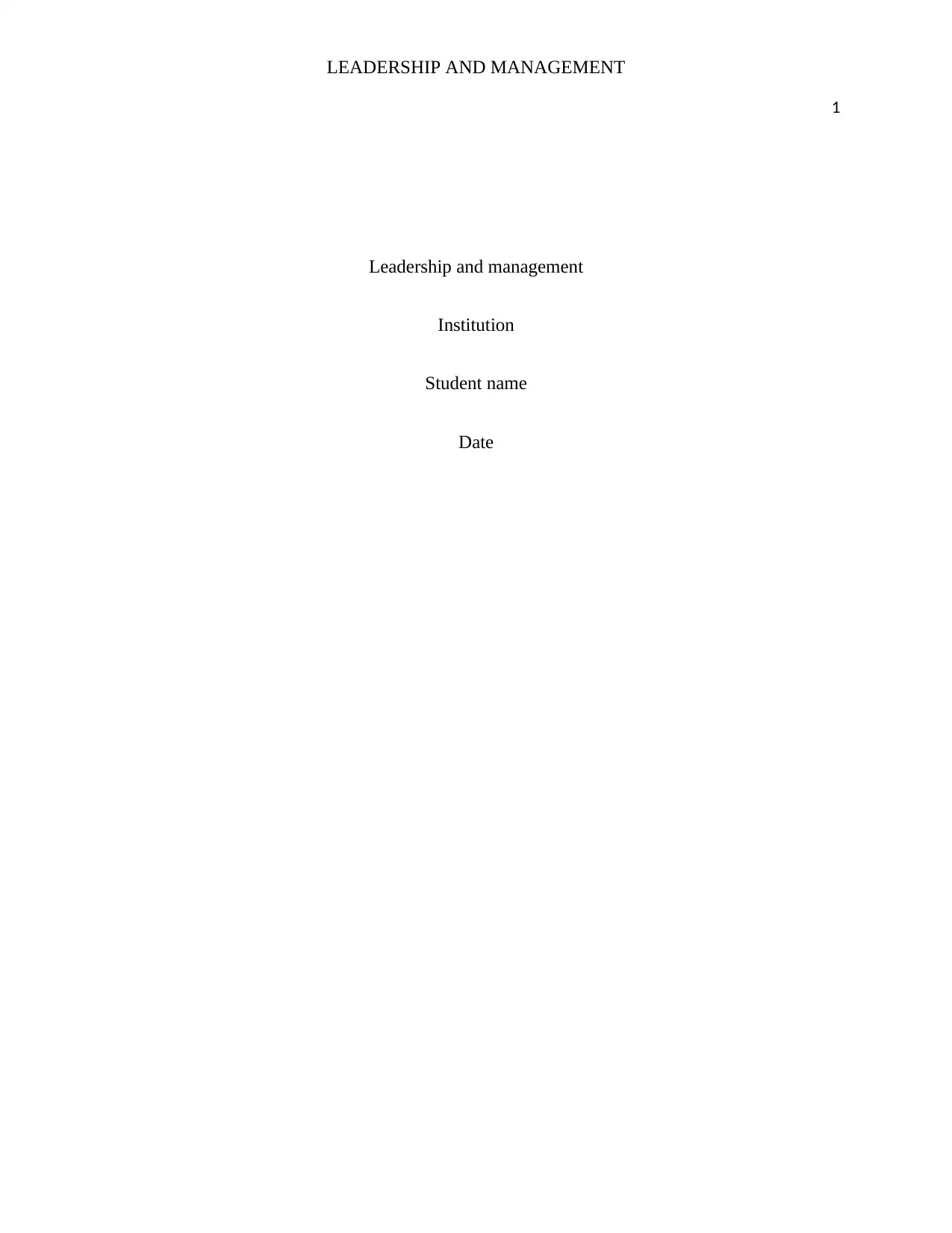
LEADERSHIP AND MANAGEMENT
1
Leadership and management
Institution
Student name
Date
1
Leadership and management
Institution
Student name
Date
Secure Best Marks with AI Grader
Need help grading? Try our AI Grader for instant feedback on your assignments.
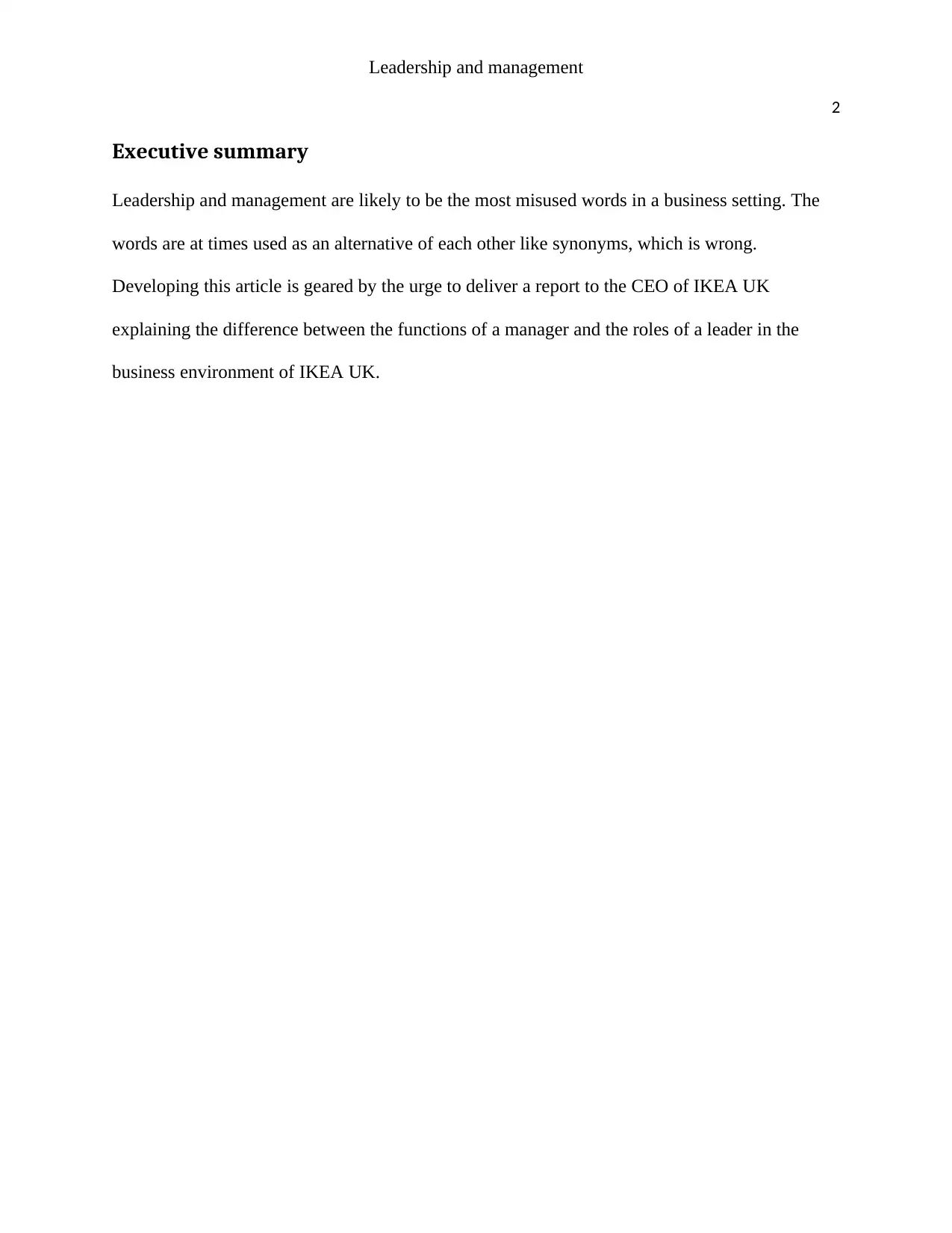
Leadership and management
2
Executive summary
Leadership and management are likely to be the most misused words in a business setting. The
words are at times used as an alternative of each other like synonyms, which is wrong.
Developing this article is geared by the urge to deliver a report to the CEO of IKEA UK
explaining the difference between the functions of a manager and the roles of a leader in the
business environment of IKEA UK.
2
Executive summary
Leadership and management are likely to be the most misused words in a business setting. The
words are at times used as an alternative of each other like synonyms, which is wrong.
Developing this article is geared by the urge to deliver a report to the CEO of IKEA UK
explaining the difference between the functions of a manager and the roles of a leader in the
business environment of IKEA UK.
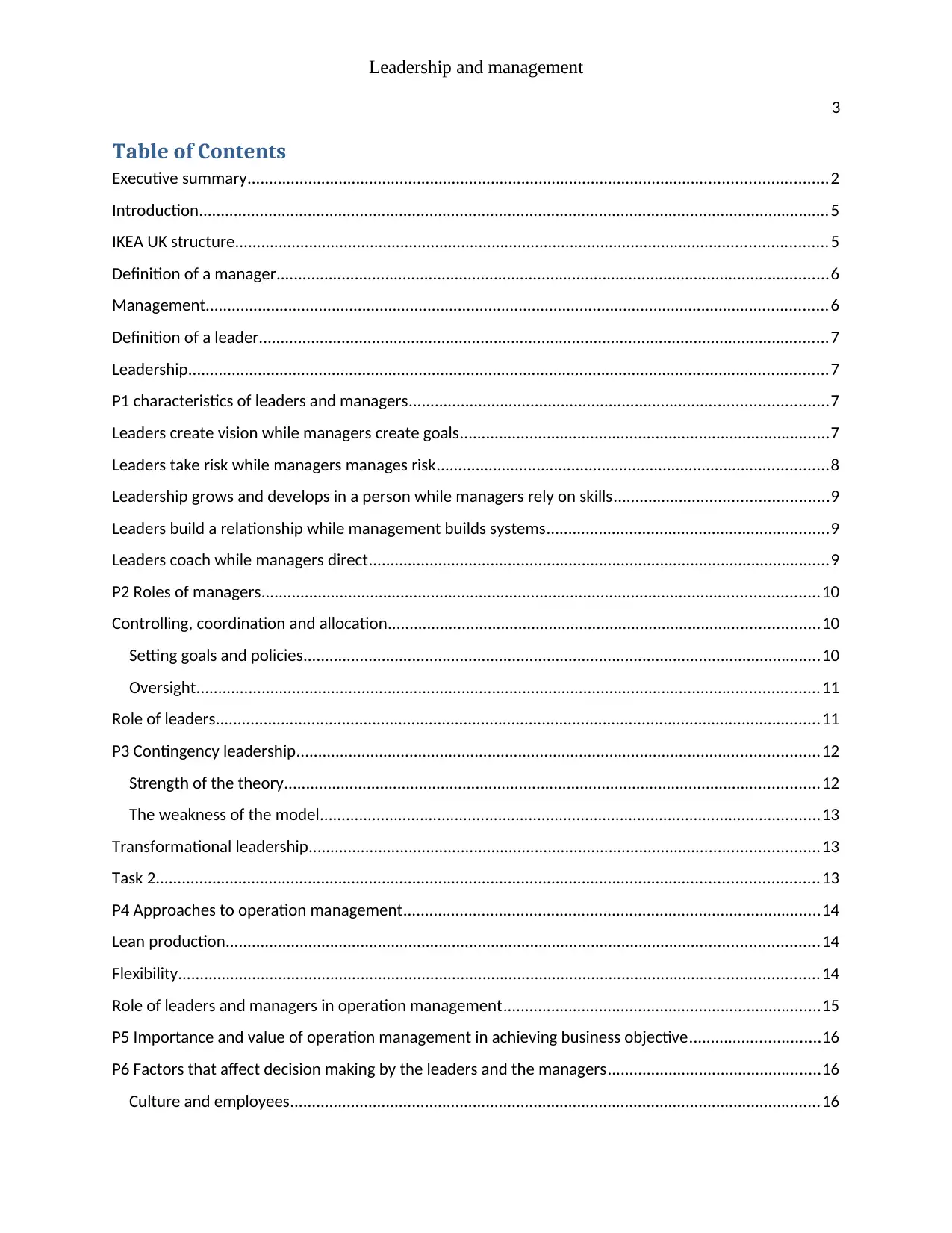
Leadership and management
3
Table of Contents
Executive summary.....................................................................................................................................2
Introduction.................................................................................................................................................5
IKEA UK structure........................................................................................................................................5
Definition of a manager...............................................................................................................................6
Management...............................................................................................................................................6
Definition of a leader...................................................................................................................................7
Leadership...................................................................................................................................................7
P1 characteristics of leaders and managers................................................................................................7
Leaders create vision while managers create goals.....................................................................................7
Leaders take risk while managers manages risk..........................................................................................8
Leadership grows and develops in a person while managers rely on skills.................................................9
Leaders build a relationship while management builds systems.................................................................9
Leaders coach while managers direct..........................................................................................................9
P2 Roles of managers................................................................................................................................10
Controlling, coordination and allocation...................................................................................................10
Setting goals and policies.......................................................................................................................10
Oversight...............................................................................................................................................11
Role of leaders...........................................................................................................................................11
P3 Contingency leadership........................................................................................................................12
Strength of the theory...........................................................................................................................12
The weakness of the model...................................................................................................................13
Transformational leadership.....................................................................................................................13
Task 2........................................................................................................................................................13
P4 Approaches to operation management................................................................................................14
Lean production........................................................................................................................................14
Flexibility...................................................................................................................................................14
Role of leaders and managers in operation management.........................................................................15
P5 Importance and value of operation management in achieving business objective..............................16
P6 Factors that affect decision making by the leaders and the managers.................................................16
Culture and employees..........................................................................................................................16
3
Table of Contents
Executive summary.....................................................................................................................................2
Introduction.................................................................................................................................................5
IKEA UK structure........................................................................................................................................5
Definition of a manager...............................................................................................................................6
Management...............................................................................................................................................6
Definition of a leader...................................................................................................................................7
Leadership...................................................................................................................................................7
P1 characteristics of leaders and managers................................................................................................7
Leaders create vision while managers create goals.....................................................................................7
Leaders take risk while managers manages risk..........................................................................................8
Leadership grows and develops in a person while managers rely on skills.................................................9
Leaders build a relationship while management builds systems.................................................................9
Leaders coach while managers direct..........................................................................................................9
P2 Roles of managers................................................................................................................................10
Controlling, coordination and allocation...................................................................................................10
Setting goals and policies.......................................................................................................................10
Oversight...............................................................................................................................................11
Role of leaders...........................................................................................................................................11
P3 Contingency leadership........................................................................................................................12
Strength of the theory...........................................................................................................................12
The weakness of the model...................................................................................................................13
Transformational leadership.....................................................................................................................13
Task 2........................................................................................................................................................13
P4 Approaches to operation management................................................................................................14
Lean production........................................................................................................................................14
Flexibility...................................................................................................................................................14
Role of leaders and managers in operation management.........................................................................15
P5 Importance and value of operation management in achieving business objective..............................16
P6 Factors that affect decision making by the leaders and the managers.................................................16
Culture and employees..........................................................................................................................16
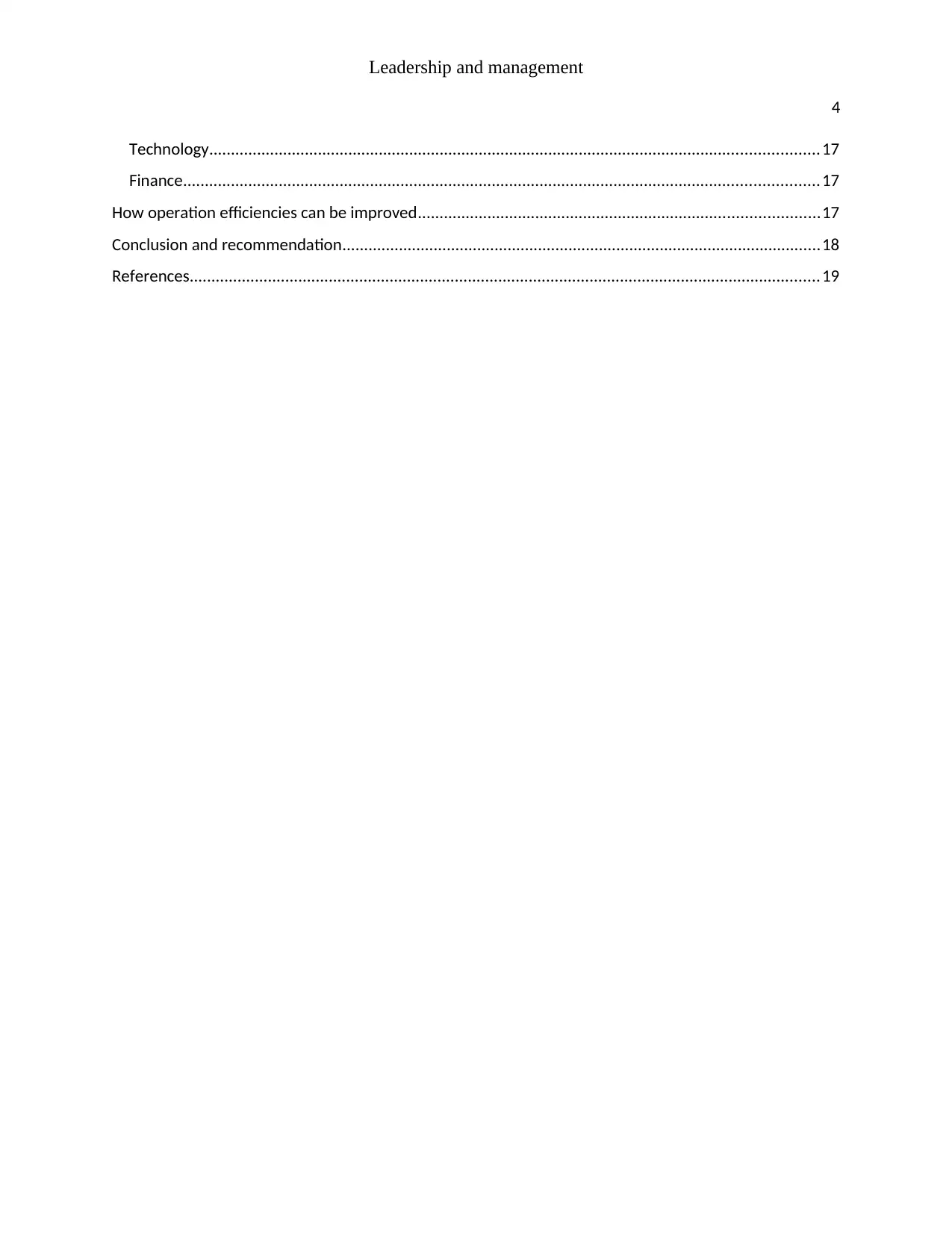
Leadership and management
4
Technology............................................................................................................................................17
Finance..................................................................................................................................................17
How operation efficiencies can be improved............................................................................................17
Conclusion and recommendation..............................................................................................................18
References.................................................................................................................................................19
4
Technology............................................................................................................................................17
Finance..................................................................................................................................................17
How operation efficiencies can be improved............................................................................................17
Conclusion and recommendation..............................................................................................................18
References.................................................................................................................................................19
Secure Best Marks with AI Grader
Need help grading? Try our AI Grader for instant feedback on your assignments.
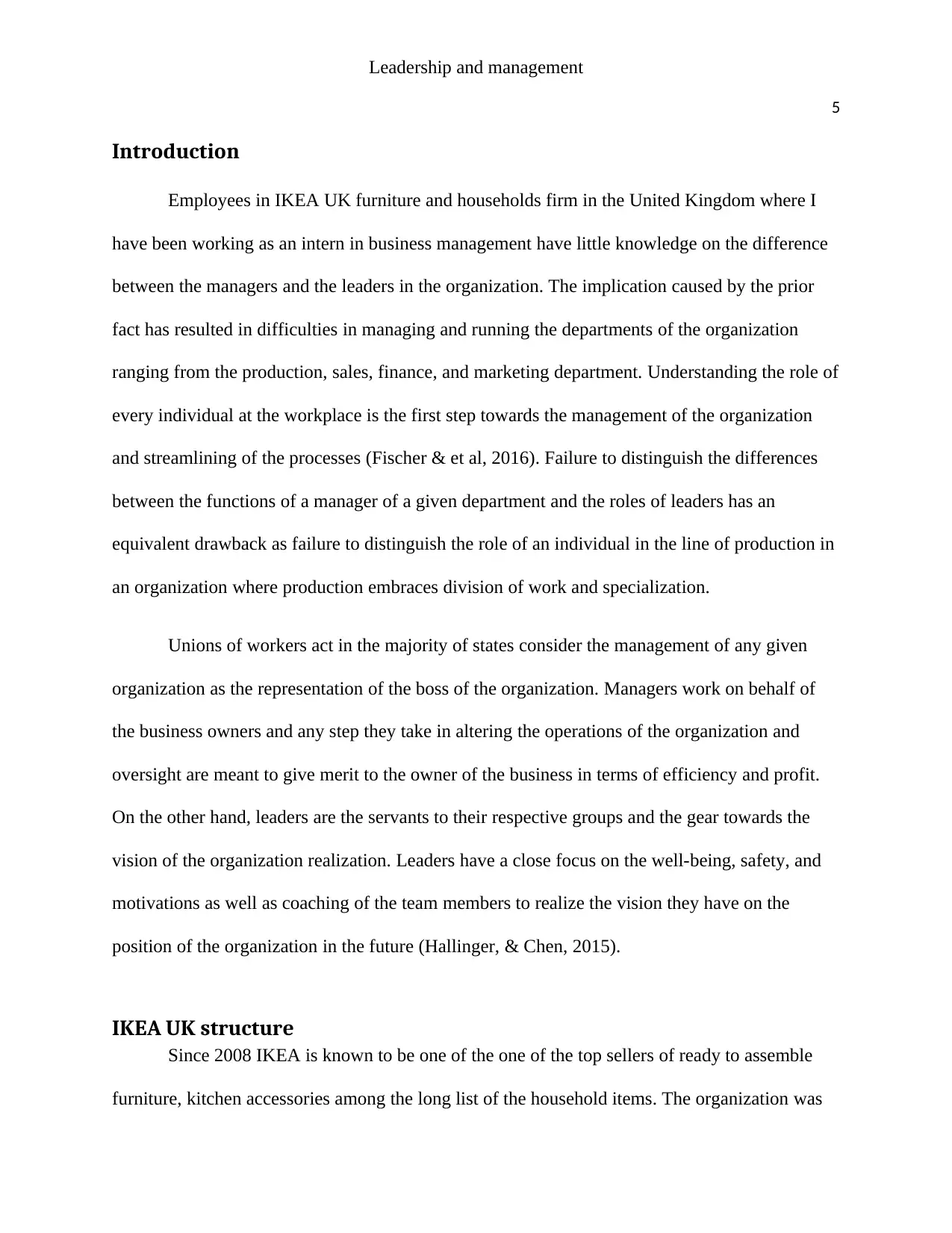
Leadership and management
5
Introduction
Employees in IKEA UK furniture and households firm in the United Kingdom where I
have been working as an intern in business management have little knowledge on the difference
between the managers and the leaders in the organization. The implication caused by the prior
fact has resulted in difficulties in managing and running the departments of the organization
ranging from the production, sales, finance, and marketing department. Understanding the role of
every individual at the workplace is the first step towards the management of the organization
and streamlining of the processes (Fischer & et al, 2016). Failure to distinguish the differences
between the functions of a manager of a given department and the roles of leaders has an
equivalent drawback as failure to distinguish the role of an individual in the line of production in
an organization where production embraces division of work and specialization.
Unions of workers act in the majority of states consider the management of any given
organization as the representation of the boss of the organization. Managers work on behalf of
the business owners and any step they take in altering the operations of the organization and
oversight are meant to give merit to the owner of the business in terms of efficiency and profit.
On the other hand, leaders are the servants to their respective groups and the gear towards the
vision of the organization realization. Leaders have a close focus on the well-being, safety, and
motivations as well as coaching of the team members to realize the vision they have on the
position of the organization in the future (Hallinger, & Chen, 2015).
IKEA UK structure
Since 2008 IKEA is known to be one of the one of the top sellers of ready to assemble
furniture, kitchen accessories among the long list of the household items. The organization was
5
Introduction
Employees in IKEA UK furniture and households firm in the United Kingdom where I
have been working as an intern in business management have little knowledge on the difference
between the managers and the leaders in the organization. The implication caused by the prior
fact has resulted in difficulties in managing and running the departments of the organization
ranging from the production, sales, finance, and marketing department. Understanding the role of
every individual at the workplace is the first step towards the management of the organization
and streamlining of the processes (Fischer & et al, 2016). Failure to distinguish the differences
between the functions of a manager of a given department and the roles of leaders has an
equivalent drawback as failure to distinguish the role of an individual in the line of production in
an organization where production embraces division of work and specialization.
Unions of workers act in the majority of states consider the management of any given
organization as the representation of the boss of the organization. Managers work on behalf of
the business owners and any step they take in altering the operations of the organization and
oversight are meant to give merit to the owner of the business in terms of efficiency and profit.
On the other hand, leaders are the servants to their respective groups and the gear towards the
vision of the organization realization. Leaders have a close focus on the well-being, safety, and
motivations as well as coaching of the team members to realize the vision they have on the
position of the organization in the future (Hallinger, & Chen, 2015).
IKEA UK structure
Since 2008 IKEA is known to be one of the one of the top sellers of ready to assemble
furniture, kitchen accessories among the long list of the household items. The organization was
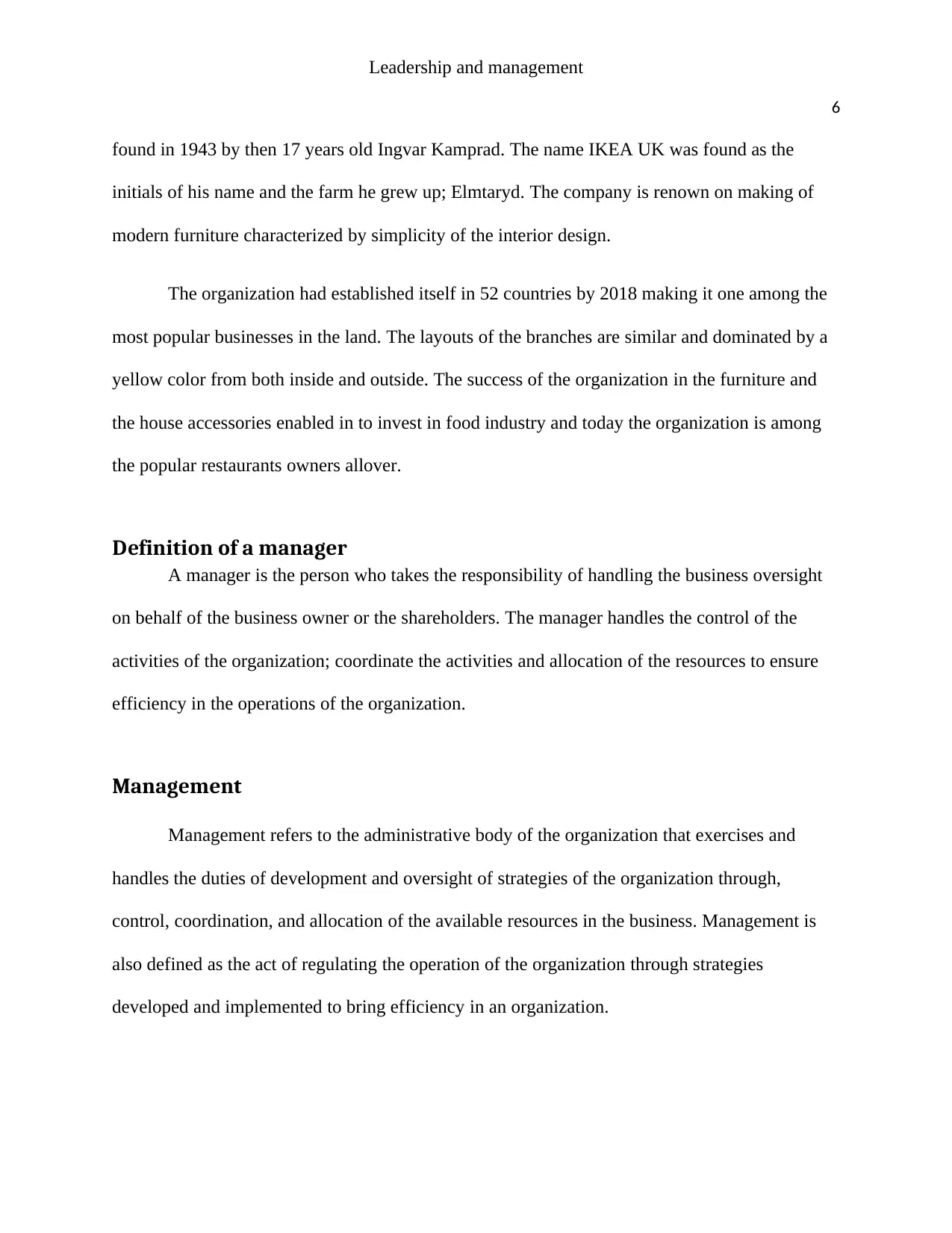
Leadership and management
6
found in 1943 by then 17 years old Ingvar Kamprad. The name IKEA UK was found as the
initials of his name and the farm he grew up; Elmtaryd. The company is renown on making of
modern furniture characterized by simplicity of the interior design.
The organization had established itself in 52 countries by 2018 making it one among the
most popular businesses in the land. The layouts of the branches are similar and dominated by a
yellow color from both inside and outside. The success of the organization in the furniture and
the house accessories enabled in to invest in food industry and today the organization is among
the popular restaurants owners allover.
Definition of a manager
A manager is the person who takes the responsibility of handling the business oversight
on behalf of the business owner or the shareholders. The manager handles the control of the
activities of the organization; coordinate the activities and allocation of the resources to ensure
efficiency in the operations of the organization.
Management
Management refers to the administrative body of the organization that exercises and
handles the duties of development and oversight of strategies of the organization through,
control, coordination, and allocation of the available resources in the business. Management is
also defined as the act of regulating the operation of the organization through strategies
developed and implemented to bring efficiency in an organization.
6
found in 1943 by then 17 years old Ingvar Kamprad. The name IKEA UK was found as the
initials of his name and the farm he grew up; Elmtaryd. The company is renown on making of
modern furniture characterized by simplicity of the interior design.
The organization had established itself in 52 countries by 2018 making it one among the
most popular businesses in the land. The layouts of the branches are similar and dominated by a
yellow color from both inside and outside. The success of the organization in the furniture and
the house accessories enabled in to invest in food industry and today the organization is among
the popular restaurants owners allover.
Definition of a manager
A manager is the person who takes the responsibility of handling the business oversight
on behalf of the business owner or the shareholders. The manager handles the control of the
activities of the organization; coordinate the activities and allocation of the resources to ensure
efficiency in the operations of the organization.
Management
Management refers to the administrative body of the organization that exercises and
handles the duties of development and oversight of strategies of the organization through,
control, coordination, and allocation of the available resources in the business. Management is
also defined as the act of regulating the operation of the organization through strategies
developed and implemented to bring efficiency in an organization.
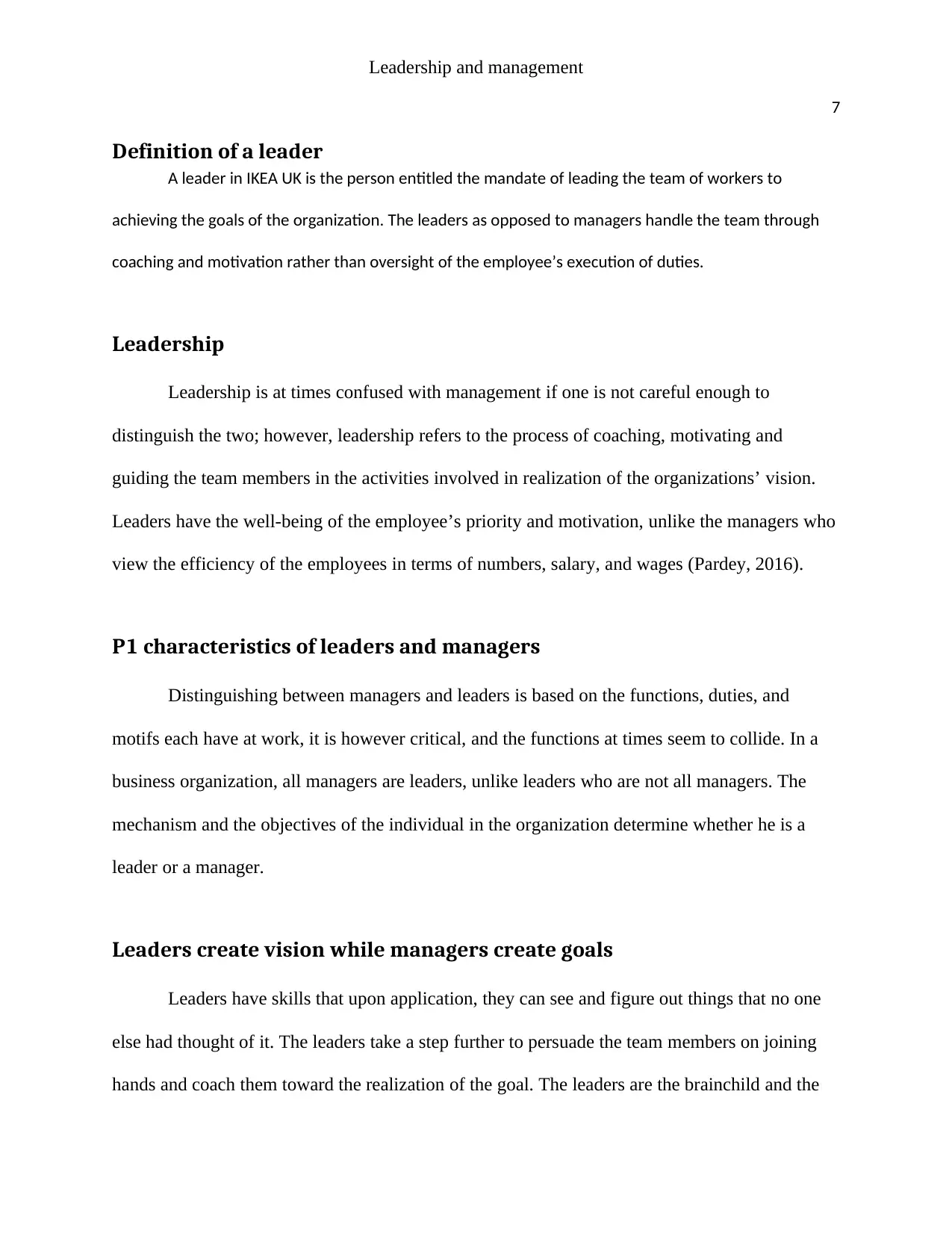
Leadership and management
7
Definition of a leader
A leader in IKEA UK is the person entitled the mandate of leading the team of workers to
achieving the goals of the organization. The leaders as opposed to managers handle the team through
coaching and motivation rather than oversight of the employee’s execution of duties.
Leadership
Leadership is at times confused with management if one is not careful enough to
distinguish the two; however, leadership refers to the process of coaching, motivating and
guiding the team members in the activities involved in realization of the organizations’ vision.
Leaders have the well-being of the employee’s priority and motivation, unlike the managers who
view the efficiency of the employees in terms of numbers, salary, and wages (Pardey, 2016).
P1 characteristics of leaders and managers
Distinguishing between managers and leaders is based on the functions, duties, and
motifs each have at work, it is however critical, and the functions at times seem to collide. In a
business organization, all managers are leaders, unlike leaders who are not all managers. The
mechanism and the objectives of the individual in the organization determine whether he is a
leader or a manager.
Leaders create vision while managers create goals
Leaders have skills that upon application, they can see and figure out things that no one
else had thought of it. The leaders take a step further to persuade the team members on joining
hands and coach them toward the realization of the goal. The leaders are the brainchild and the
7
Definition of a leader
A leader in IKEA UK is the person entitled the mandate of leading the team of workers to
achieving the goals of the organization. The leaders as opposed to managers handle the team through
coaching and motivation rather than oversight of the employee’s execution of duties.
Leadership
Leadership is at times confused with management if one is not careful enough to
distinguish the two; however, leadership refers to the process of coaching, motivating and
guiding the team members in the activities involved in realization of the organizations’ vision.
Leaders have the well-being of the employee’s priority and motivation, unlike the managers who
view the efficiency of the employees in terms of numbers, salary, and wages (Pardey, 2016).
P1 characteristics of leaders and managers
Distinguishing between managers and leaders is based on the functions, duties, and
motifs each have at work, it is however critical, and the functions at times seem to collide. In a
business organization, all managers are leaders, unlike leaders who are not all managers. The
mechanism and the objectives of the individual in the organization determine whether he is a
leader or a manager.
Leaders create vision while managers create goals
Leaders have skills that upon application, they can see and figure out things that no one
else had thought of it. The leaders take a step further to persuade the team members on joining
hands and coach them toward the realization of the goal. The leaders are the brainchild and the
Paraphrase This Document
Need a fresh take? Get an instant paraphrase of this document with our AI Paraphraser
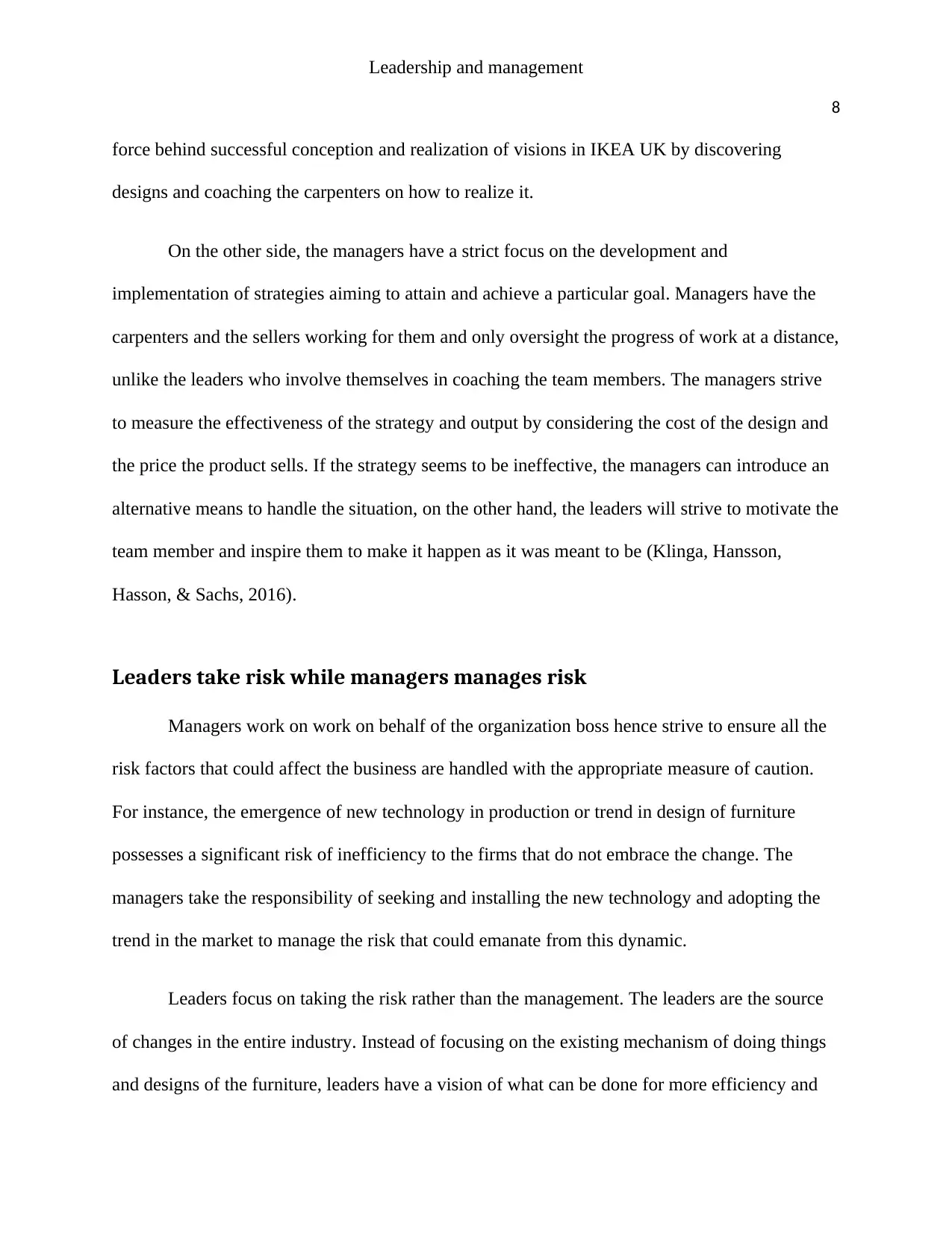
Leadership and management
8
force behind successful conception and realization of visions in IKEA UK by discovering
designs and coaching the carpenters on how to realize it.
On the other side, the managers have a strict focus on the development and
implementation of strategies aiming to attain and achieve a particular goal. Managers have the
carpenters and the sellers working for them and only oversight the progress of work at a distance,
unlike the leaders who involve themselves in coaching the team members. The managers strive
to measure the effectiveness of the strategy and output by considering the cost of the design and
the price the product sells. If the strategy seems to be ineffective, the managers can introduce an
alternative means to handle the situation, on the other hand, the leaders will strive to motivate the
team member and inspire them to make it happen as it was meant to be (Klinga, Hansson,
Hasson, & Sachs, 2016).
Leaders take risk while managers manages risk
Managers work on work on behalf of the organization boss hence strive to ensure all the
risk factors that could affect the business are handled with the appropriate measure of caution.
For instance, the emergence of new technology in production or trend in design of furniture
possesses a significant risk of inefficiency to the firms that do not embrace the change. The
managers take the responsibility of seeking and installing the new technology and adopting the
trend in the market to manage the risk that could emanate from this dynamic.
Leaders focus on taking the risk rather than the management. The leaders are the source
of changes in the entire industry. Instead of focusing on the existing mechanism of doing things
and designs of the furniture, leaders have a vision of what can be done for more efficiency and
8
force behind successful conception and realization of visions in IKEA UK by discovering
designs and coaching the carpenters on how to realize it.
On the other side, the managers have a strict focus on the development and
implementation of strategies aiming to attain and achieve a particular goal. Managers have the
carpenters and the sellers working for them and only oversight the progress of work at a distance,
unlike the leaders who involve themselves in coaching the team members. The managers strive
to measure the effectiveness of the strategy and output by considering the cost of the design and
the price the product sells. If the strategy seems to be ineffective, the managers can introduce an
alternative means to handle the situation, on the other hand, the leaders will strive to motivate the
team member and inspire them to make it happen as it was meant to be (Klinga, Hansson,
Hasson, & Sachs, 2016).
Leaders take risk while managers manages risk
Managers work on work on behalf of the organization boss hence strive to ensure all the
risk factors that could affect the business are handled with the appropriate measure of caution.
For instance, the emergence of new technology in production or trend in design of furniture
possesses a significant risk of inefficiency to the firms that do not embrace the change. The
managers take the responsibility of seeking and installing the new technology and adopting the
trend in the market to manage the risk that could emanate from this dynamic.
Leaders focus on taking the risk rather than the management. The leaders are the source
of changes in the entire industry. Instead of focusing on the existing mechanism of doing things
and designs of the furniture, leaders have a vision of what can be done for more efficiency and
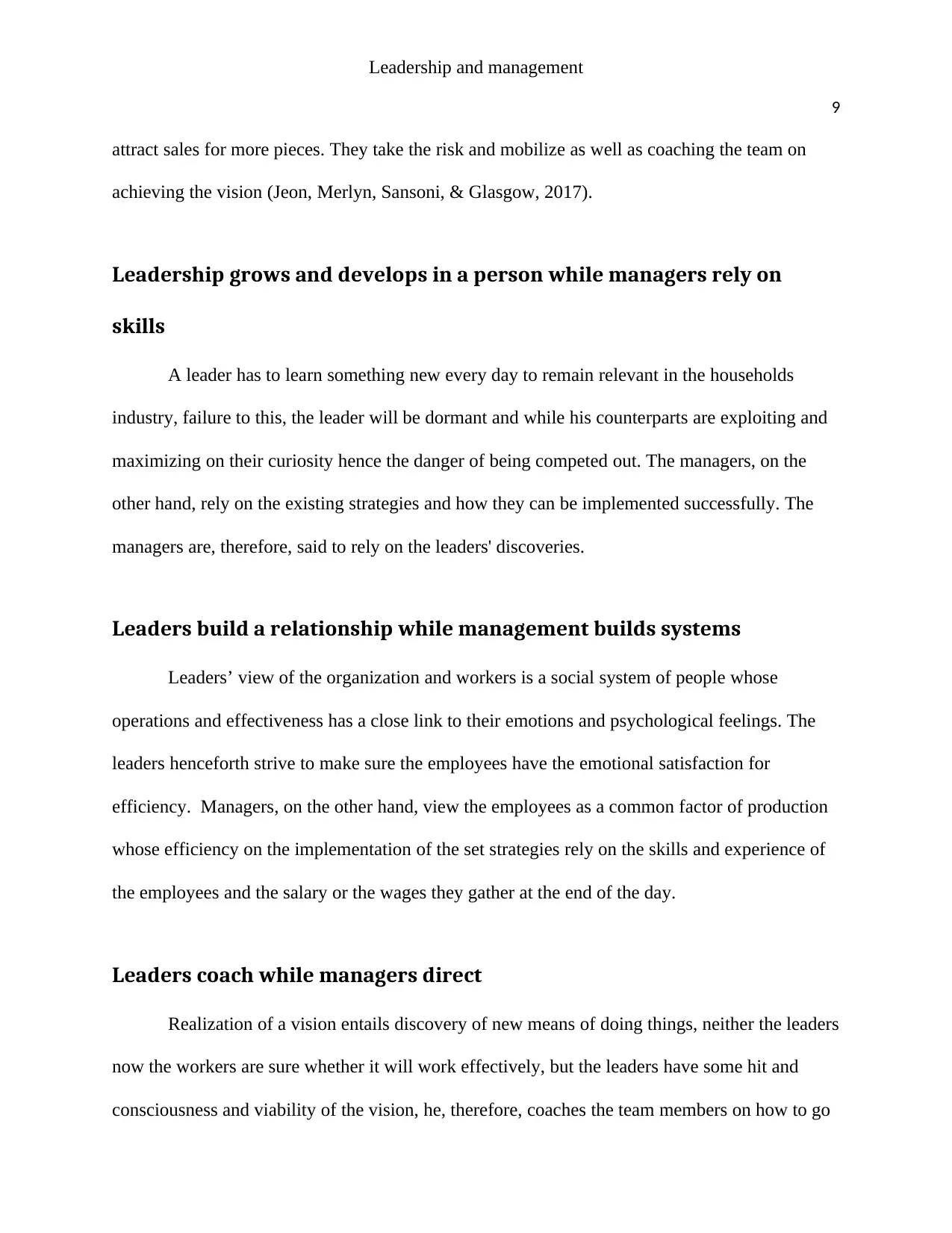
Leadership and management
9
attract sales for more pieces. They take the risk and mobilize as well as coaching the team on
achieving the vision (Jeon, Merlyn, Sansoni, & Glasgow, 2017).
Leadership grows and develops in a person while managers rely on
skills
A leader has to learn something new every day to remain relevant in the households
industry, failure to this, the leader will be dormant and while his counterparts are exploiting and
maximizing on their curiosity hence the danger of being competed out. The managers, on the
other hand, rely on the existing strategies and how they can be implemented successfully. The
managers are, therefore, said to rely on the leaders' discoveries.
Leaders build a relationship while management builds systems
Leaders’ view of the organization and workers is a social system of people whose
operations and effectiveness has a close link to their emotions and psychological feelings. The
leaders henceforth strive to make sure the employees have the emotional satisfaction for
efficiency. Managers, on the other hand, view the employees as a common factor of production
whose efficiency on the implementation of the set strategies rely on the skills and experience of
the employees and the salary or the wages they gather at the end of the day.
Leaders coach while managers direct
Realization of a vision entails discovery of new means of doing things, neither the leaders
now the workers are sure whether it will work effectively, but the leaders have some hit and
consciousness and viability of the vision, he, therefore, coaches the team members on how to go
9
attract sales for more pieces. They take the risk and mobilize as well as coaching the team on
achieving the vision (Jeon, Merlyn, Sansoni, & Glasgow, 2017).
Leadership grows and develops in a person while managers rely on
skills
A leader has to learn something new every day to remain relevant in the households
industry, failure to this, the leader will be dormant and while his counterparts are exploiting and
maximizing on their curiosity hence the danger of being competed out. The managers, on the
other hand, rely on the existing strategies and how they can be implemented successfully. The
managers are, therefore, said to rely on the leaders' discoveries.
Leaders build a relationship while management builds systems
Leaders’ view of the organization and workers is a social system of people whose
operations and effectiveness has a close link to their emotions and psychological feelings. The
leaders henceforth strive to make sure the employees have the emotional satisfaction for
efficiency. Managers, on the other hand, view the employees as a common factor of production
whose efficiency on the implementation of the set strategies rely on the skills and experience of
the employees and the salary or the wages they gather at the end of the day.
Leaders coach while managers direct
Realization of a vision entails discovery of new means of doing things, neither the leaders
now the workers are sure whether it will work effectively, but the leaders have some hit and
consciousness and viability of the vision, he, therefore, coaches the team members on how to go
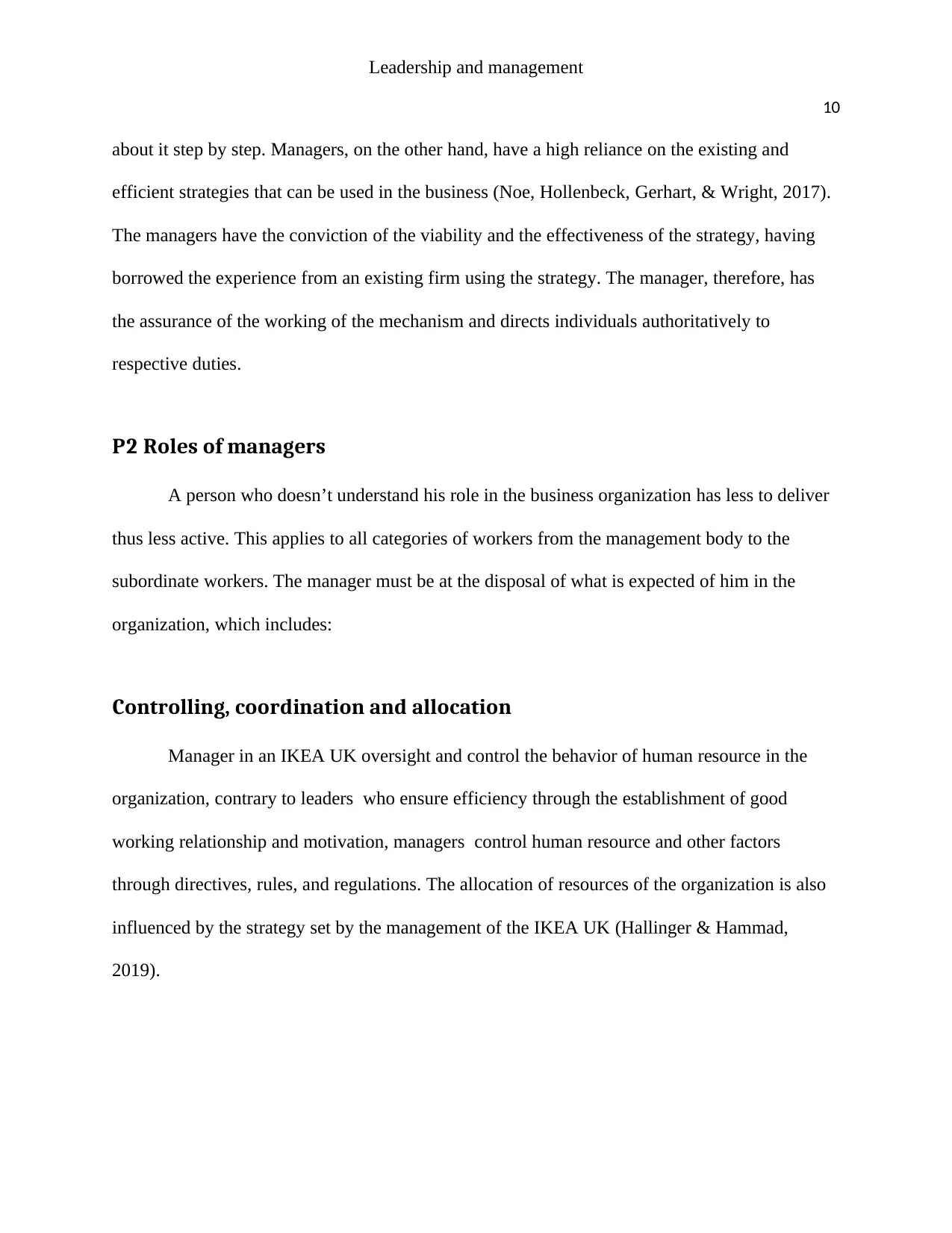
Leadership and management
10
about it step by step. Managers, on the other hand, have a high reliance on the existing and
efficient strategies that can be used in the business (Noe, Hollenbeck, Gerhart, & Wright, 2017).
The managers have the conviction of the viability and the effectiveness of the strategy, having
borrowed the experience from an existing firm using the strategy. The manager, therefore, has
the assurance of the working of the mechanism and directs individuals authoritatively to
respective duties.
P2 Roles of managers
A person who doesn’t understand his role in the business organization has less to deliver
thus less active. This applies to all categories of workers from the management body to the
subordinate workers. The manager must be at the disposal of what is expected of him in the
organization, which includes:
Controlling, coordination and allocation
Manager in an IKEA UK oversight and control the behavior of human resource in the
organization, contrary to leaders who ensure efficiency through the establishment of good
working relationship and motivation, managers control human resource and other factors
through directives, rules, and regulations. The allocation of resources of the organization is also
influenced by the strategy set by the management of the IKEA UK (Hallinger & Hammad,
2019).
10
about it step by step. Managers, on the other hand, have a high reliance on the existing and
efficient strategies that can be used in the business (Noe, Hollenbeck, Gerhart, & Wright, 2017).
The managers have the conviction of the viability and the effectiveness of the strategy, having
borrowed the experience from an existing firm using the strategy. The manager, therefore, has
the assurance of the working of the mechanism and directs individuals authoritatively to
respective duties.
P2 Roles of managers
A person who doesn’t understand his role in the business organization has less to deliver
thus less active. This applies to all categories of workers from the management body to the
subordinate workers. The manager must be at the disposal of what is expected of him in the
organization, which includes:
Controlling, coordination and allocation
Manager in an IKEA UK oversight and control the behavior of human resource in the
organization, contrary to leaders who ensure efficiency through the establishment of good
working relationship and motivation, managers control human resource and other factors
through directives, rules, and regulations. The allocation of resources of the organization is also
influenced by the strategy set by the management of the IKEA UK (Hallinger & Hammad,
2019).
Secure Best Marks with AI Grader
Need help grading? Try our AI Grader for instant feedback on your assignments.
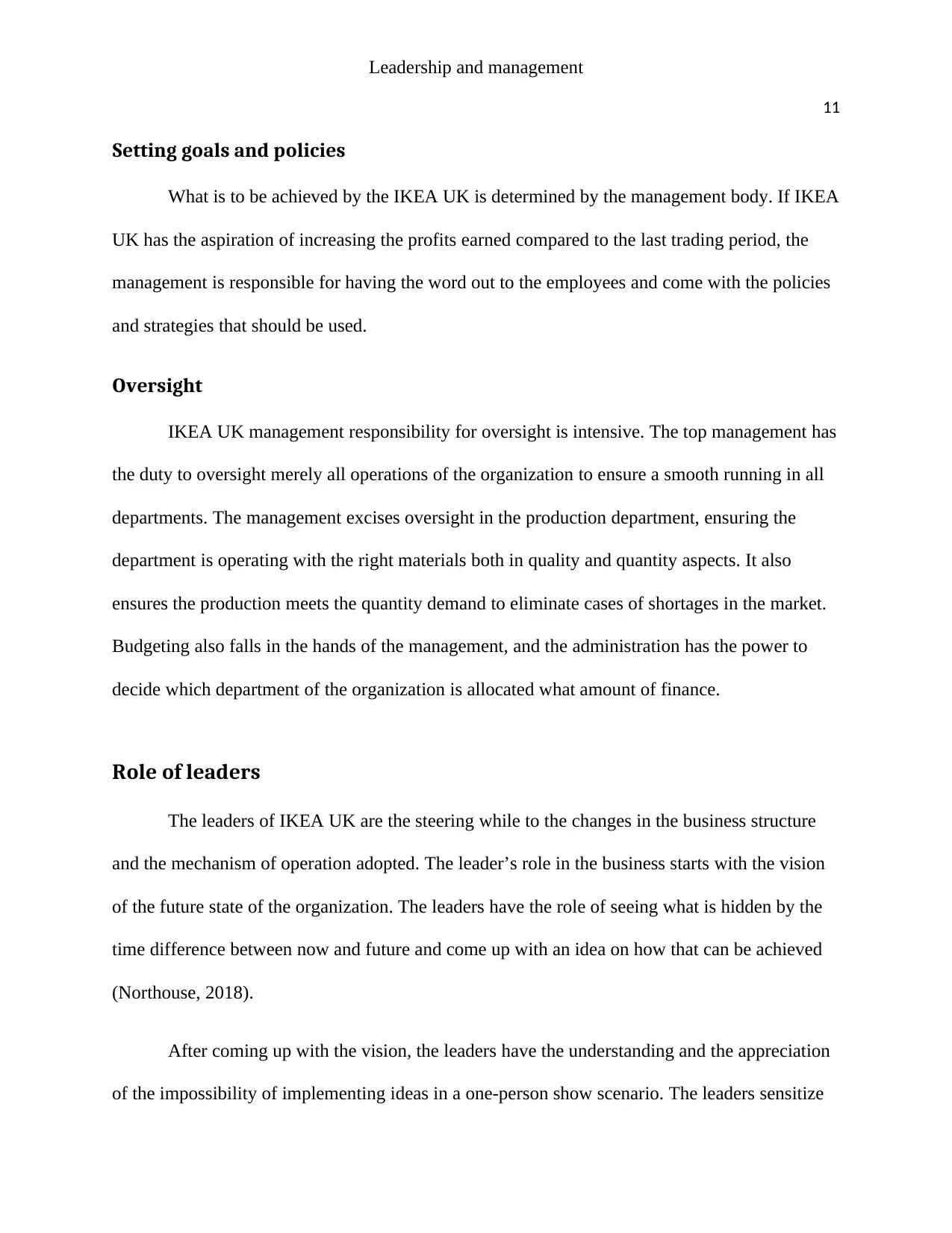
Leadership and management
11
Setting goals and policies
What is to be achieved by the IKEA UK is determined by the management body. If IKEA
UK has the aspiration of increasing the profits earned compared to the last trading period, the
management is responsible for having the word out to the employees and come with the policies
and strategies that should be used.
Oversight
IKEA UK management responsibility for oversight is intensive. The top management has
the duty to oversight merely all operations of the organization to ensure a smooth running in all
departments. The management excises oversight in the production department, ensuring the
department is operating with the right materials both in quality and quantity aspects. It also
ensures the production meets the quantity demand to eliminate cases of shortages in the market.
Budgeting also falls in the hands of the management, and the administration has the power to
decide which department of the organization is allocated what amount of finance.
Role of leaders
The leaders of IKEA UK are the steering while to the changes in the business structure
and the mechanism of operation adopted. The leader’s role in the business starts with the vision
of the future state of the organization. The leaders have the role of seeing what is hidden by the
time difference between now and future and come up with an idea on how that can be achieved
(Northouse, 2018).
After coming up with the vision, the leaders have the understanding and the appreciation
of the impossibility of implementing ideas in a one-person show scenario. The leaders sensitize
11
Setting goals and policies
What is to be achieved by the IKEA UK is determined by the management body. If IKEA
UK has the aspiration of increasing the profits earned compared to the last trading period, the
management is responsible for having the word out to the employees and come with the policies
and strategies that should be used.
Oversight
IKEA UK management responsibility for oversight is intensive. The top management has
the duty to oversight merely all operations of the organization to ensure a smooth running in all
departments. The management excises oversight in the production department, ensuring the
department is operating with the right materials both in quality and quantity aspects. It also
ensures the production meets the quantity demand to eliminate cases of shortages in the market.
Budgeting also falls in the hands of the management, and the administration has the power to
decide which department of the organization is allocated what amount of finance.
Role of leaders
The leaders of IKEA UK are the steering while to the changes in the business structure
and the mechanism of operation adopted. The leader’s role in the business starts with the vision
of the future state of the organization. The leaders have the role of seeing what is hidden by the
time difference between now and future and come up with an idea on how that can be achieved
(Northouse, 2018).
After coming up with the vision, the leaders have the understanding and the appreciation
of the impossibility of implementing ideas in a one-person show scenario. The leaders sensitize
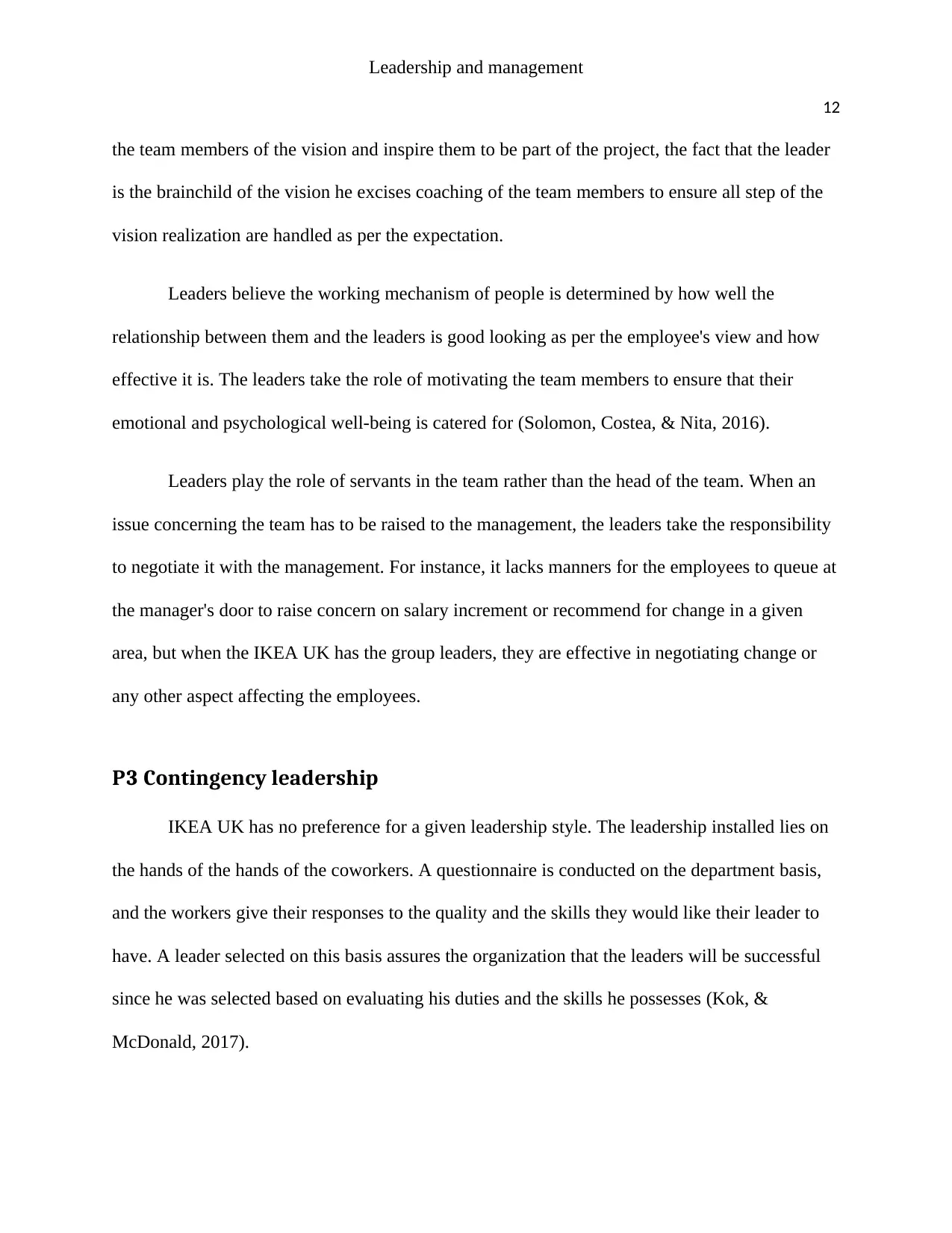
Leadership and management
12
the team members of the vision and inspire them to be part of the project, the fact that the leader
is the brainchild of the vision he excises coaching of the team members to ensure all step of the
vision realization are handled as per the expectation.
Leaders believe the working mechanism of people is determined by how well the
relationship between them and the leaders is good looking as per the employee's view and how
effective it is. The leaders take the role of motivating the team members to ensure that their
emotional and psychological well-being is catered for (Solomon, Costea, & Nita, 2016).
Leaders play the role of servants in the team rather than the head of the team. When an
issue concerning the team has to be raised to the management, the leaders take the responsibility
to negotiate it with the management. For instance, it lacks manners for the employees to queue at
the manager's door to raise concern on salary increment or recommend for change in a given
area, but when the IKEA UK has the group leaders, they are effective in negotiating change or
any other aspect affecting the employees.
P3 Contingency leadership
IKEA UK has no preference for a given leadership style. The leadership installed lies on
the hands of the hands of the coworkers. A questionnaire is conducted on the department basis,
and the workers give their responses to the quality and the skills they would like their leader to
have. A leader selected on this basis assures the organization that the leaders will be successful
since he was selected based on evaluating his duties and the skills he possesses (Kok, &
McDonald, 2017).
12
the team members of the vision and inspire them to be part of the project, the fact that the leader
is the brainchild of the vision he excises coaching of the team members to ensure all step of the
vision realization are handled as per the expectation.
Leaders believe the working mechanism of people is determined by how well the
relationship between them and the leaders is good looking as per the employee's view and how
effective it is. The leaders take the role of motivating the team members to ensure that their
emotional and psychological well-being is catered for (Solomon, Costea, & Nita, 2016).
Leaders play the role of servants in the team rather than the head of the team. When an
issue concerning the team has to be raised to the management, the leaders take the responsibility
to negotiate it with the management. For instance, it lacks manners for the employees to queue at
the manager's door to raise concern on salary increment or recommend for change in a given
area, but when the IKEA UK has the group leaders, they are effective in negotiating change or
any other aspect affecting the employees.
P3 Contingency leadership
IKEA UK has no preference for a given leadership style. The leadership installed lies on
the hands of the hands of the coworkers. A questionnaire is conducted on the department basis,
and the workers give their responses to the quality and the skills they would like their leader to
have. A leader selected on this basis assures the organization that the leaders will be successful
since he was selected based on evaluating his duties and the skills he possesses (Kok, &
McDonald, 2017).
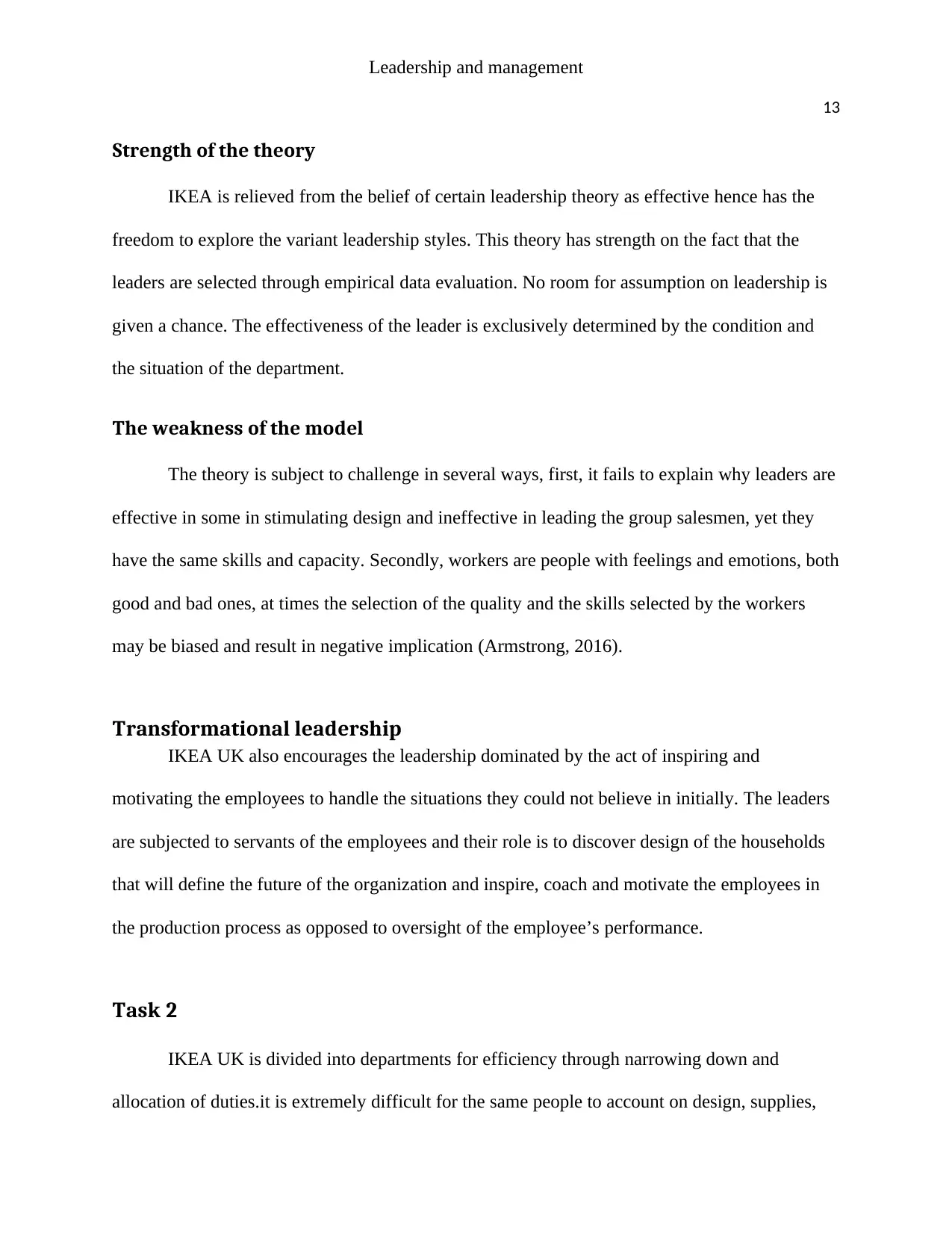
Leadership and management
13
Strength of the theory
IKEA is relieved from the belief of certain leadership theory as effective hence has the
freedom to explore the variant leadership styles. This theory has strength on the fact that the
leaders are selected through empirical data evaluation. No room for assumption on leadership is
given a chance. The effectiveness of the leader is exclusively determined by the condition and
the situation of the department.
The weakness of the model
The theory is subject to challenge in several ways, first, it fails to explain why leaders are
effective in some in stimulating design and ineffective in leading the group salesmen, yet they
have the same skills and capacity. Secondly, workers are people with feelings and emotions, both
good and bad ones, at times the selection of the quality and the skills selected by the workers
may be biased and result in negative implication (Armstrong, 2016).
Transformational leadership
IKEA UK also encourages the leadership dominated by the act of inspiring and
motivating the employees to handle the situations they could not believe in initially. The leaders
are subjected to servants of the employees and their role is to discover design of the households
that will define the future of the organization and inspire, coach and motivate the employees in
the production process as opposed to oversight of the employee’s performance.
Task 2
IKEA UK is divided into departments for efficiency through narrowing down and
allocation of duties.it is extremely difficult for the same people to account on design, supplies,
13
Strength of the theory
IKEA is relieved from the belief of certain leadership theory as effective hence has the
freedom to explore the variant leadership styles. This theory has strength on the fact that the
leaders are selected through empirical data evaluation. No room for assumption on leadership is
given a chance. The effectiveness of the leader is exclusively determined by the condition and
the situation of the department.
The weakness of the model
The theory is subject to challenge in several ways, first, it fails to explain why leaders are
effective in some in stimulating design and ineffective in leading the group salesmen, yet they
have the same skills and capacity. Secondly, workers are people with feelings and emotions, both
good and bad ones, at times the selection of the quality and the skills selected by the workers
may be biased and result in negative implication (Armstrong, 2016).
Transformational leadership
IKEA UK also encourages the leadership dominated by the act of inspiring and
motivating the employees to handle the situations they could not believe in initially. The leaders
are subjected to servants of the employees and their role is to discover design of the households
that will define the future of the organization and inspire, coach and motivate the employees in
the production process as opposed to oversight of the employee’s performance.
Task 2
IKEA UK is divided into departments for efficiency through narrowing down and
allocation of duties.it is extremely difficult for the same people to account on design, supplies,
Paraphrase This Document
Need a fresh take? Get an instant paraphrase of this document with our AI Paraphraser
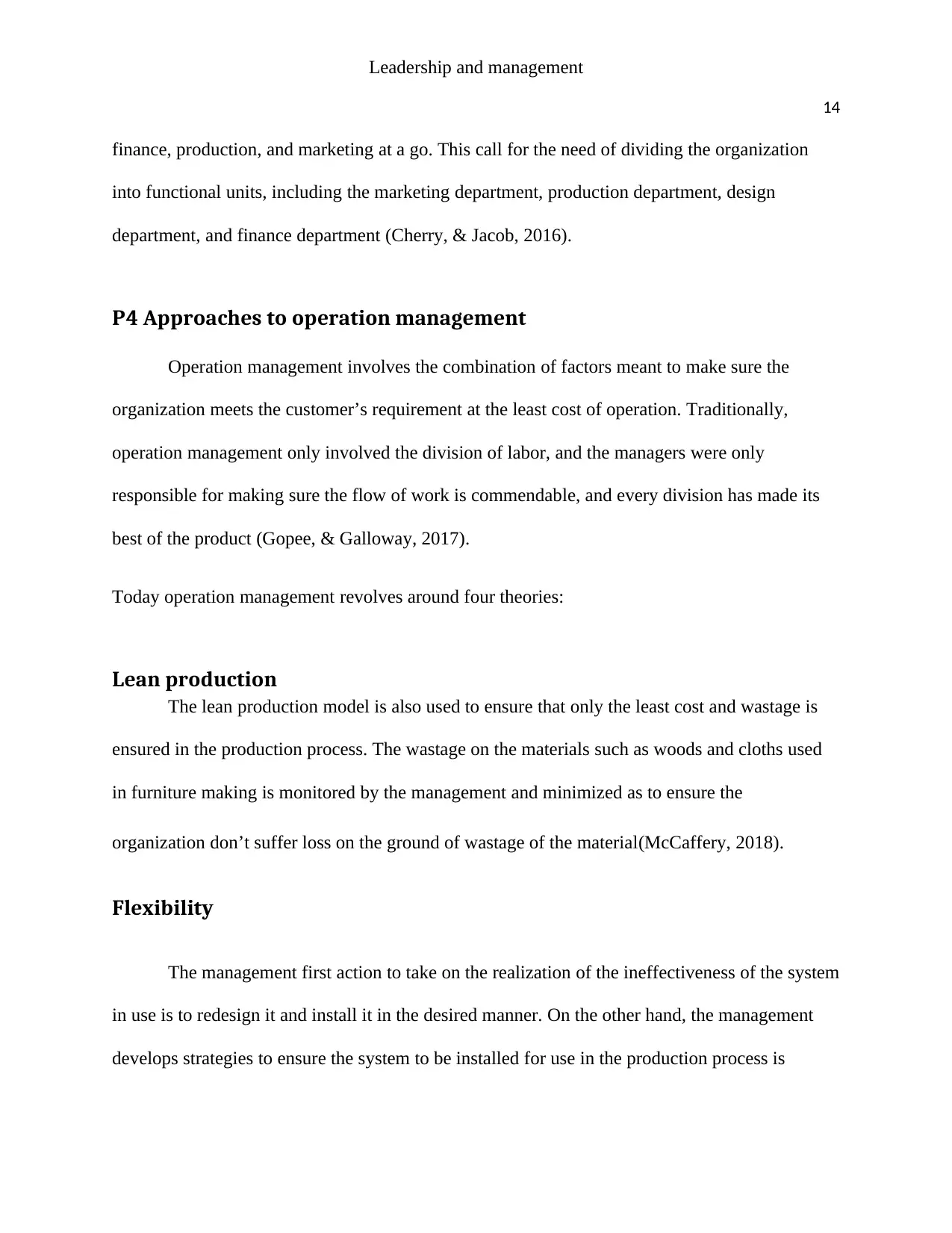
Leadership and management
14
finance, production, and marketing at a go. This call for the need of dividing the organization
into functional units, including the marketing department, production department, design
department, and finance department (Cherry, & Jacob, 2016).
P4 Approaches to operation management
Operation management involves the combination of factors meant to make sure the
organization meets the customer’s requirement at the least cost of operation. Traditionally,
operation management only involved the division of labor, and the managers were only
responsible for making sure the flow of work is commendable, and every division has made its
best of the product (Gopee, & Galloway, 2017).
Today operation management revolves around four theories:
Lean production
The lean production model is also used to ensure that only the least cost and wastage is
ensured in the production process. The wastage on the materials such as woods and cloths used
in furniture making is monitored by the management and minimized as to ensure the
organization don’t suffer loss on the ground of wastage of the material(McCaffery, 2018).
Flexibility
The management first action to take on the realization of the ineffectiveness of the system
in use is to redesign it and install it in the desired manner. On the other hand, the management
develops strategies to ensure the system to be installed for use in the production process is
14
finance, production, and marketing at a go. This call for the need of dividing the organization
into functional units, including the marketing department, production department, design
department, and finance department (Cherry, & Jacob, 2016).
P4 Approaches to operation management
Operation management involves the combination of factors meant to make sure the
organization meets the customer’s requirement at the least cost of operation. Traditionally,
operation management only involved the division of labor, and the managers were only
responsible for making sure the flow of work is commendable, and every division has made its
best of the product (Gopee, & Galloway, 2017).
Today operation management revolves around four theories:
Lean production
The lean production model is also used to ensure that only the least cost and wastage is
ensured in the production process. The wastage on the materials such as woods and cloths used
in furniture making is monitored by the management and minimized as to ensure the
organization don’t suffer loss on the ground of wastage of the material(McCaffery, 2018).
Flexibility
The management first action to take on the realization of the ineffectiveness of the system
in use is to redesign it and install it in the desired manner. On the other hand, the management
develops strategies to ensure the system to be installed for use in the production process is
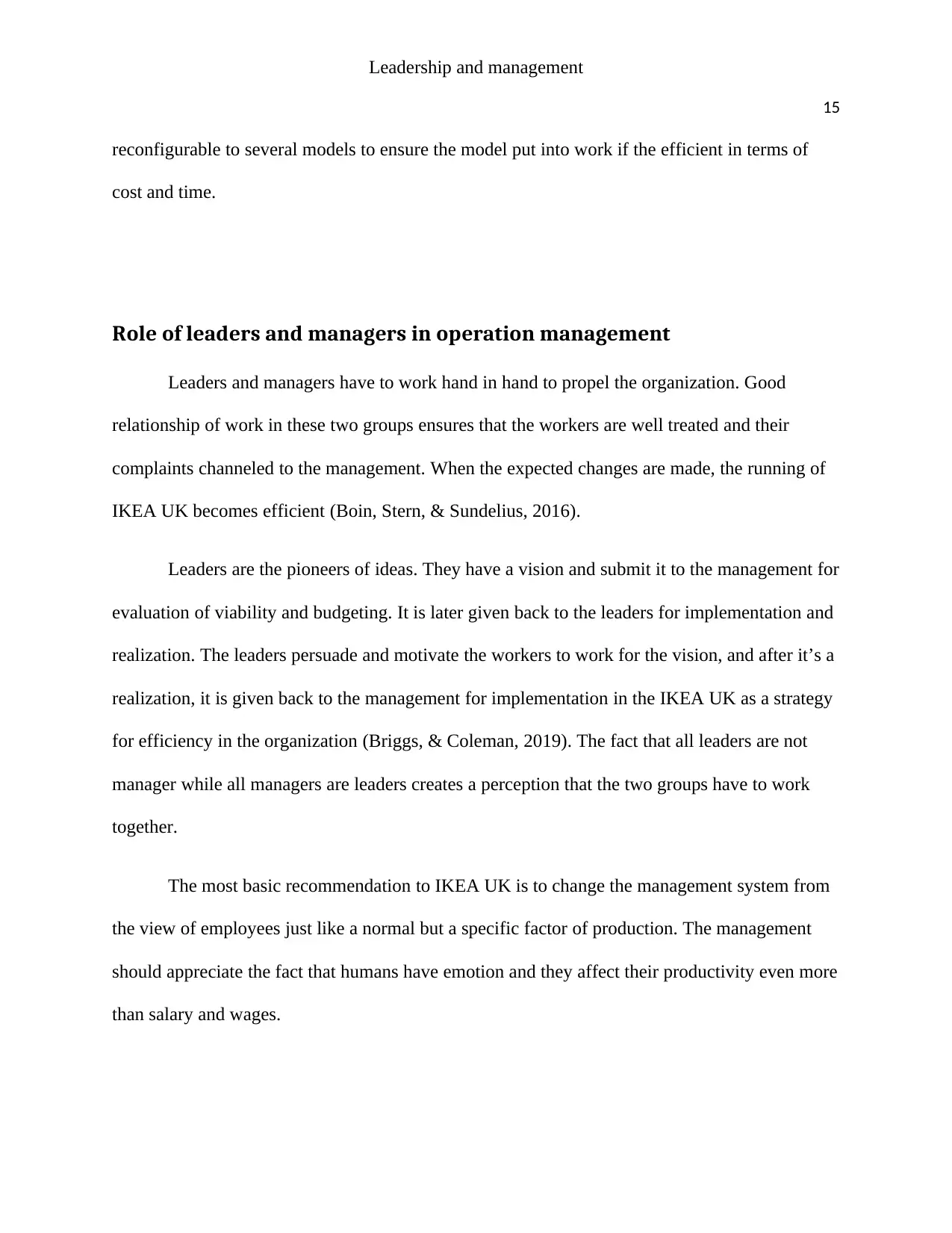
Leadership and management
15
reconfigurable to several models to ensure the model put into work if the efficient in terms of
cost and time.
Role of leaders and managers in operation management
Leaders and managers have to work hand in hand to propel the organization. Good
relationship of work in these two groups ensures that the workers are well treated and their
complaints channeled to the management. When the expected changes are made, the running of
IKEA UK becomes efficient (Boin, Stern, & Sundelius, 2016).
Leaders are the pioneers of ideas. They have a vision and submit it to the management for
evaluation of viability and budgeting. It is later given back to the leaders for implementation and
realization. The leaders persuade and motivate the workers to work for the vision, and after it’s a
realization, it is given back to the management for implementation in the IKEA UK as a strategy
for efficiency in the organization (Briggs, & Coleman, 2019). The fact that all leaders are not
manager while all managers are leaders creates a perception that the two groups have to work
together.
The most basic recommendation to IKEA UK is to change the management system from
the view of employees just like a normal but a specific factor of production. The management
should appreciate the fact that humans have emotion and they affect their productivity even more
than salary and wages.
15
reconfigurable to several models to ensure the model put into work if the efficient in terms of
cost and time.
Role of leaders and managers in operation management
Leaders and managers have to work hand in hand to propel the organization. Good
relationship of work in these two groups ensures that the workers are well treated and their
complaints channeled to the management. When the expected changes are made, the running of
IKEA UK becomes efficient (Boin, Stern, & Sundelius, 2016).
Leaders are the pioneers of ideas. They have a vision and submit it to the management for
evaluation of viability and budgeting. It is later given back to the leaders for implementation and
realization. The leaders persuade and motivate the workers to work for the vision, and after it’s a
realization, it is given back to the management for implementation in the IKEA UK as a strategy
for efficiency in the organization (Briggs, & Coleman, 2019). The fact that all leaders are not
manager while all managers are leaders creates a perception that the two groups have to work
together.
The most basic recommendation to IKEA UK is to change the management system from
the view of employees just like a normal but a specific factor of production. The management
should appreciate the fact that humans have emotion and they affect their productivity even more
than salary and wages.
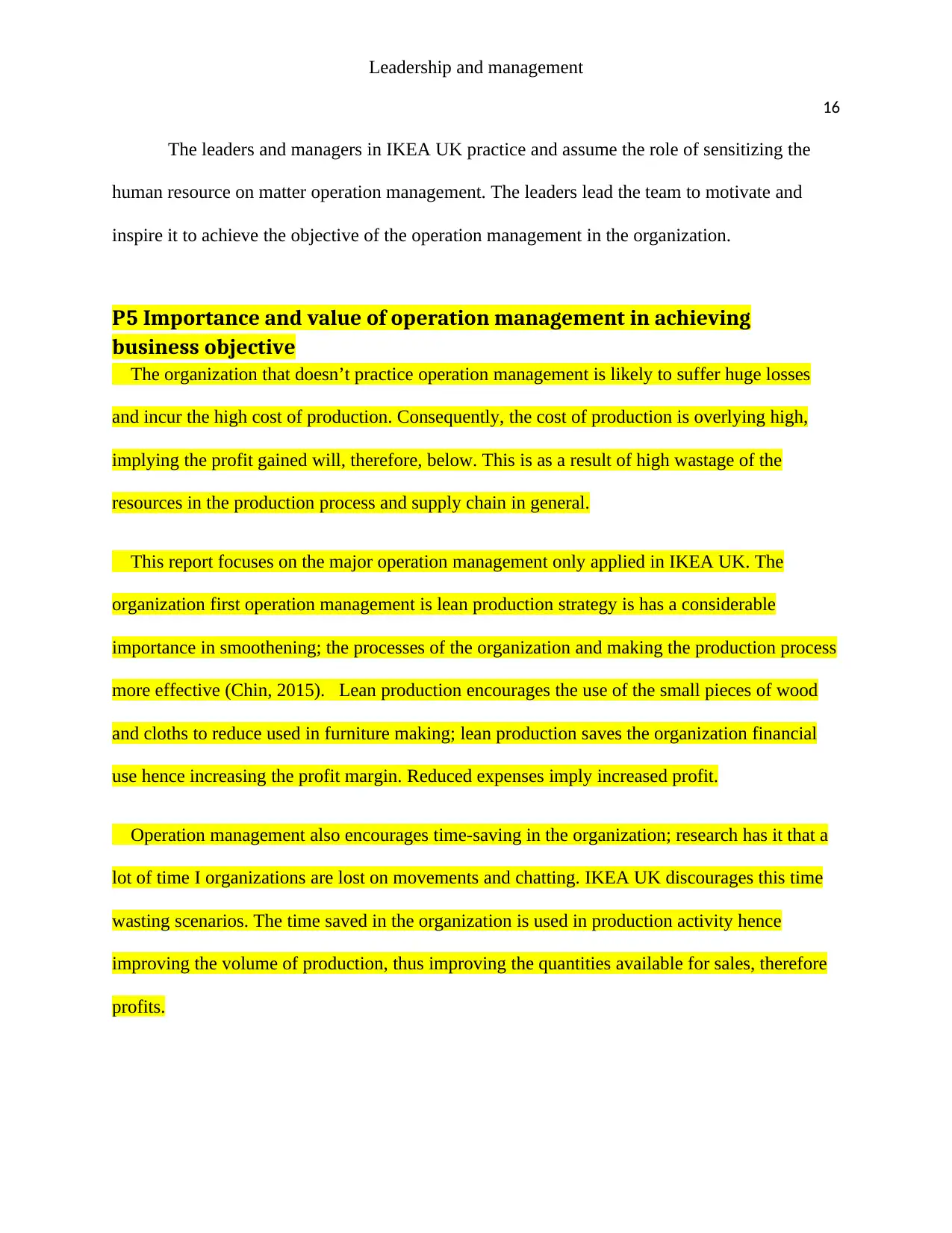
Leadership and management
16
The leaders and managers in IKEA UK practice and assume the role of sensitizing the
human resource on matter operation management. The leaders lead the team to motivate and
inspire it to achieve the objective of the operation management in the organization.
P5 Importance and value of operation management in achieving
business objective
The organization that doesn’t practice operation management is likely to suffer huge losses
and incur the high cost of production. Consequently, the cost of production is overlying high,
implying the profit gained will, therefore, below. This is as a result of high wastage of the
resources in the production process and supply chain in general.
This report focuses on the major operation management only applied in IKEA UK. The
organization first operation management is lean production strategy is has a considerable
importance in smoothening; the processes of the organization and making the production process
more effective (Chin, 2015). Lean production encourages the use of the small pieces of wood
and cloths to reduce used in furniture making; lean production saves the organization financial
use hence increasing the profit margin. Reduced expenses imply increased profit.
Operation management also encourages time-saving in the organization; research has it that a
lot of time I organizations are lost on movements and chatting. IKEA UK discourages this time
wasting scenarios. The time saved in the organization is used in production activity hence
improving the volume of production, thus improving the quantities available for sales, therefore
profits.
16
The leaders and managers in IKEA UK practice and assume the role of sensitizing the
human resource on matter operation management. The leaders lead the team to motivate and
inspire it to achieve the objective of the operation management in the organization.
P5 Importance and value of operation management in achieving
business objective
The organization that doesn’t practice operation management is likely to suffer huge losses
and incur the high cost of production. Consequently, the cost of production is overlying high,
implying the profit gained will, therefore, below. This is as a result of high wastage of the
resources in the production process and supply chain in general.
This report focuses on the major operation management only applied in IKEA UK. The
organization first operation management is lean production strategy is has a considerable
importance in smoothening; the processes of the organization and making the production process
more effective (Chin, 2015). Lean production encourages the use of the small pieces of wood
and cloths to reduce used in furniture making; lean production saves the organization financial
use hence increasing the profit margin. Reduced expenses imply increased profit.
Operation management also encourages time-saving in the organization; research has it that a
lot of time I organizations are lost on movements and chatting. IKEA UK discourages this time
wasting scenarios. The time saved in the organization is used in production activity hence
improving the volume of production, thus improving the quantities available for sales, therefore
profits.
Secure Best Marks with AI Grader
Need help grading? Try our AI Grader for instant feedback on your assignments.
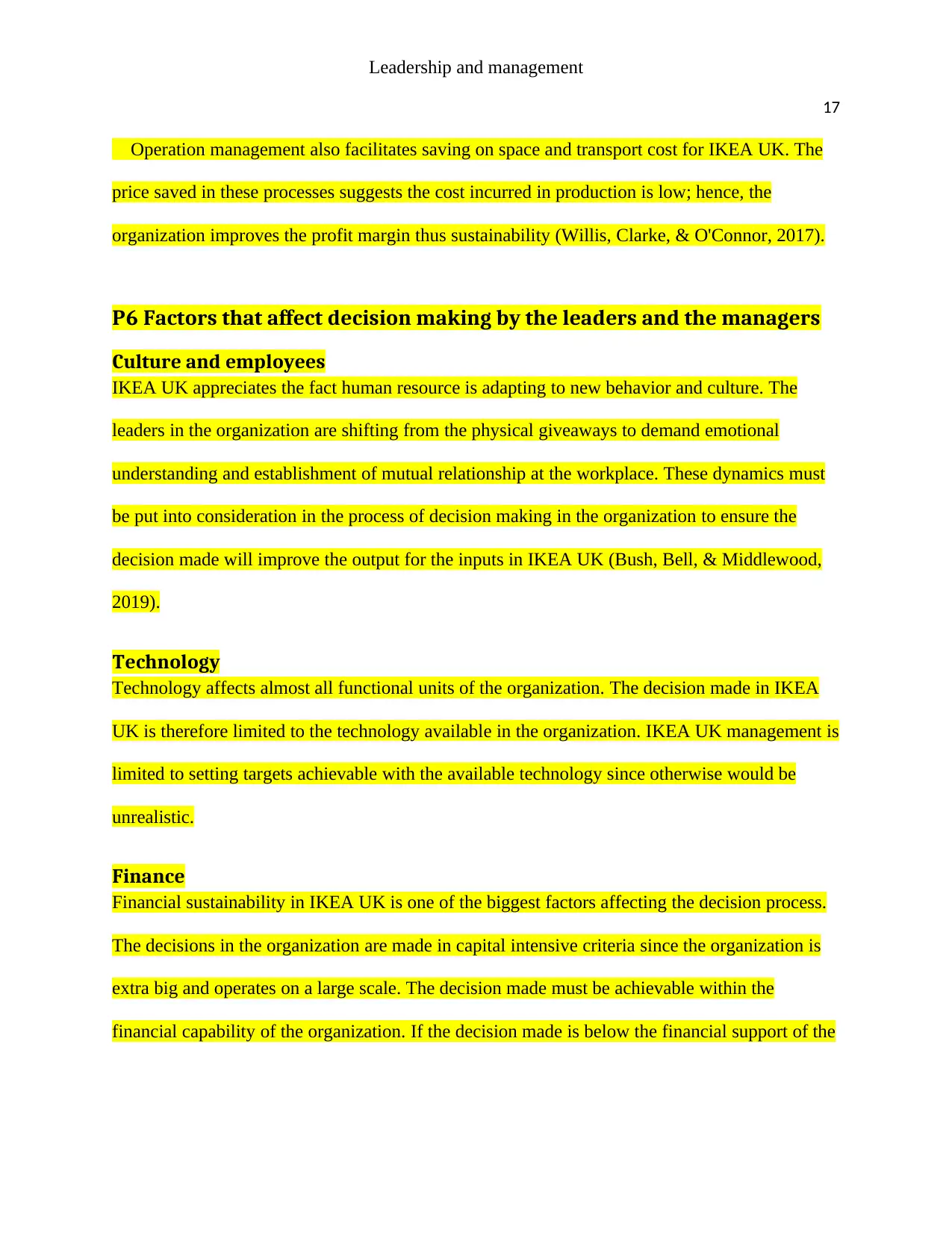
Leadership and management
17
Operation management also facilitates saving on space and transport cost for IKEA UK. The
price saved in these processes suggests the cost incurred in production is low; hence, the
organization improves the profit margin thus sustainability (Willis, Clarke, & O'Connor, 2017).
P6 Factors that affect decision making by the leaders and the managers
Culture and employees
IKEA UK appreciates the fact human resource is adapting to new behavior and culture. The
leaders in the organization are shifting from the physical giveaways to demand emotional
understanding and establishment of mutual relationship at the workplace. These dynamics must
be put into consideration in the process of decision making in the organization to ensure the
decision made will improve the output for the inputs in IKEA UK (Bush, Bell, & Middlewood,
2019).
Technology
Technology affects almost all functional units of the organization. The decision made in IKEA
UK is therefore limited to the technology available in the organization. IKEA UK management is
limited to setting targets achievable with the available technology since otherwise would be
unrealistic.
Finance
Financial sustainability in IKEA UK is one of the biggest factors affecting the decision process.
The decisions in the organization are made in capital intensive criteria since the organization is
extra big and operates on a large scale. The decision made must be achievable within the
financial capability of the organization. If the decision made is below the financial support of the
17
Operation management also facilitates saving on space and transport cost for IKEA UK. The
price saved in these processes suggests the cost incurred in production is low; hence, the
organization improves the profit margin thus sustainability (Willis, Clarke, & O'Connor, 2017).
P6 Factors that affect decision making by the leaders and the managers
Culture and employees
IKEA UK appreciates the fact human resource is adapting to new behavior and culture. The
leaders in the organization are shifting from the physical giveaways to demand emotional
understanding and establishment of mutual relationship at the workplace. These dynamics must
be put into consideration in the process of decision making in the organization to ensure the
decision made will improve the output for the inputs in IKEA UK (Bush, Bell, & Middlewood,
2019).
Technology
Technology affects almost all functional units of the organization. The decision made in IKEA
UK is therefore limited to the technology available in the organization. IKEA UK management is
limited to setting targets achievable with the available technology since otherwise would be
unrealistic.
Finance
Financial sustainability in IKEA UK is one of the biggest factors affecting the decision process.
The decisions in the organization are made in capital intensive criteria since the organization is
extra big and operates on a large scale. The decision made must be achievable within the
financial capability of the organization. If the decision made is below the financial support of the
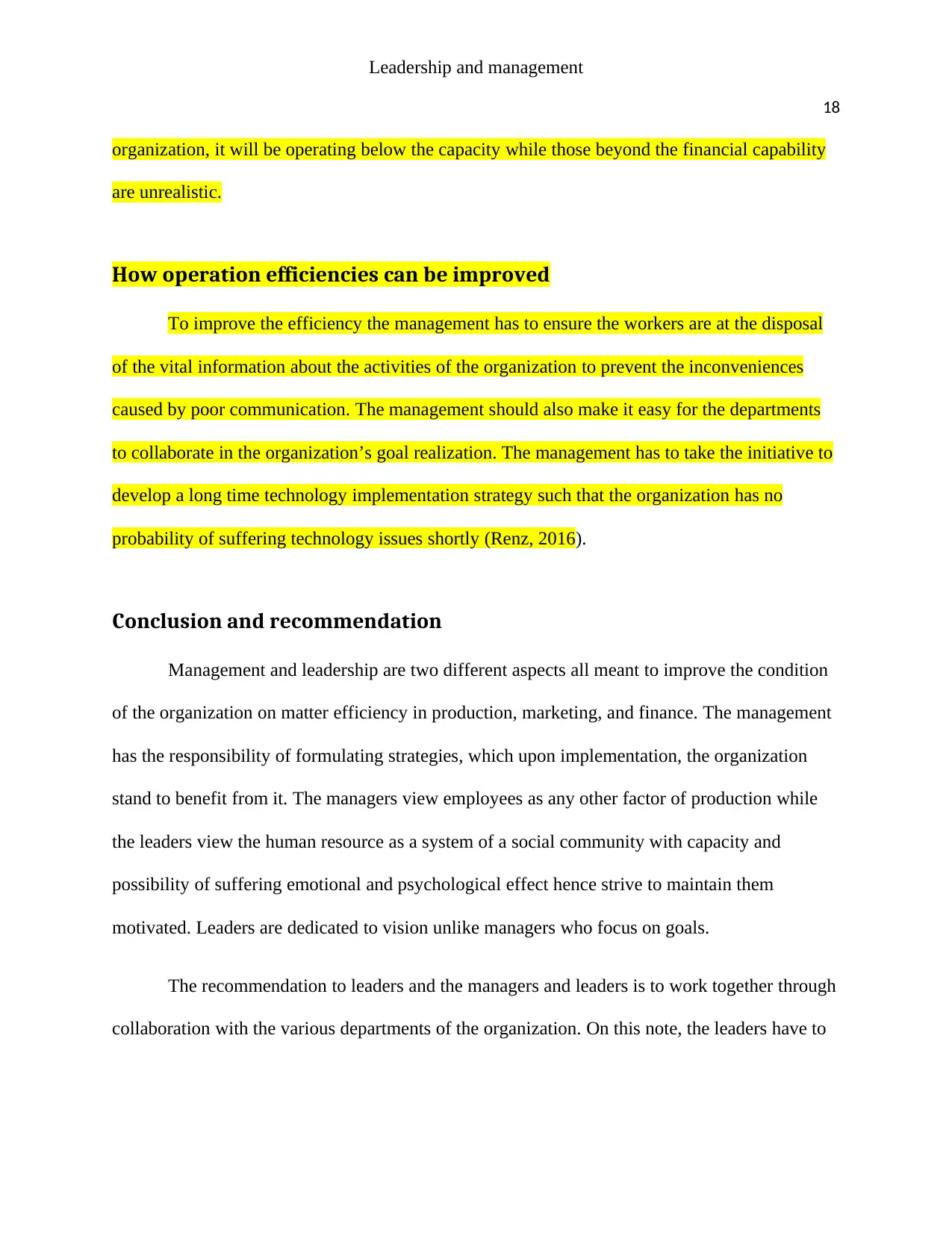
Leadership and management
18
organization, it will be operating below the capacity while those beyond the financial capability
are unrealistic.
How operation efficiencies can be improved
To improve the efficiency the management has to ensure the workers are at the disposal
of the vital information about the activities of the organization to prevent the inconveniences
caused by poor communication. The management should also make it easy for the departments
to collaborate in the organization’s goal realization. The management has to take the initiative to
develop a long time technology implementation strategy such that the organization has no
probability of suffering technology issues shortly (Renz, 2016).
Conclusion and recommendation
Management and leadership are two different aspects all meant to improve the condition
of the organization on matter efficiency in production, marketing, and finance. The management
has the responsibility of formulating strategies, which upon implementation, the organization
stand to benefit from it. The managers view employees as any other factor of production while
the leaders view the human resource as a system of a social community with capacity and
possibility of suffering emotional and psychological effect hence strive to maintain them
motivated. Leaders are dedicated to vision unlike managers who focus on goals.
The recommendation to leaders and the managers and leaders is to work together through
collaboration with the various departments of the organization. On this note, the leaders have to
18
organization, it will be operating below the capacity while those beyond the financial capability
are unrealistic.
How operation efficiencies can be improved
To improve the efficiency the management has to ensure the workers are at the disposal
of the vital information about the activities of the organization to prevent the inconveniences
caused by poor communication. The management should also make it easy for the departments
to collaborate in the organization’s goal realization. The management has to take the initiative to
develop a long time technology implementation strategy such that the organization has no
probability of suffering technology issues shortly (Renz, 2016).
Conclusion and recommendation
Management and leadership are two different aspects all meant to improve the condition
of the organization on matter efficiency in production, marketing, and finance. The management
has the responsibility of formulating strategies, which upon implementation, the organization
stand to benefit from it. The managers view employees as any other factor of production while
the leaders view the human resource as a system of a social community with capacity and
possibility of suffering emotional and psychological effect hence strive to maintain them
motivated. Leaders are dedicated to vision unlike managers who focus on goals.
The recommendation to leaders and the managers and leaders is to work together through
collaboration with the various departments of the organization. On this note, the leaders have to
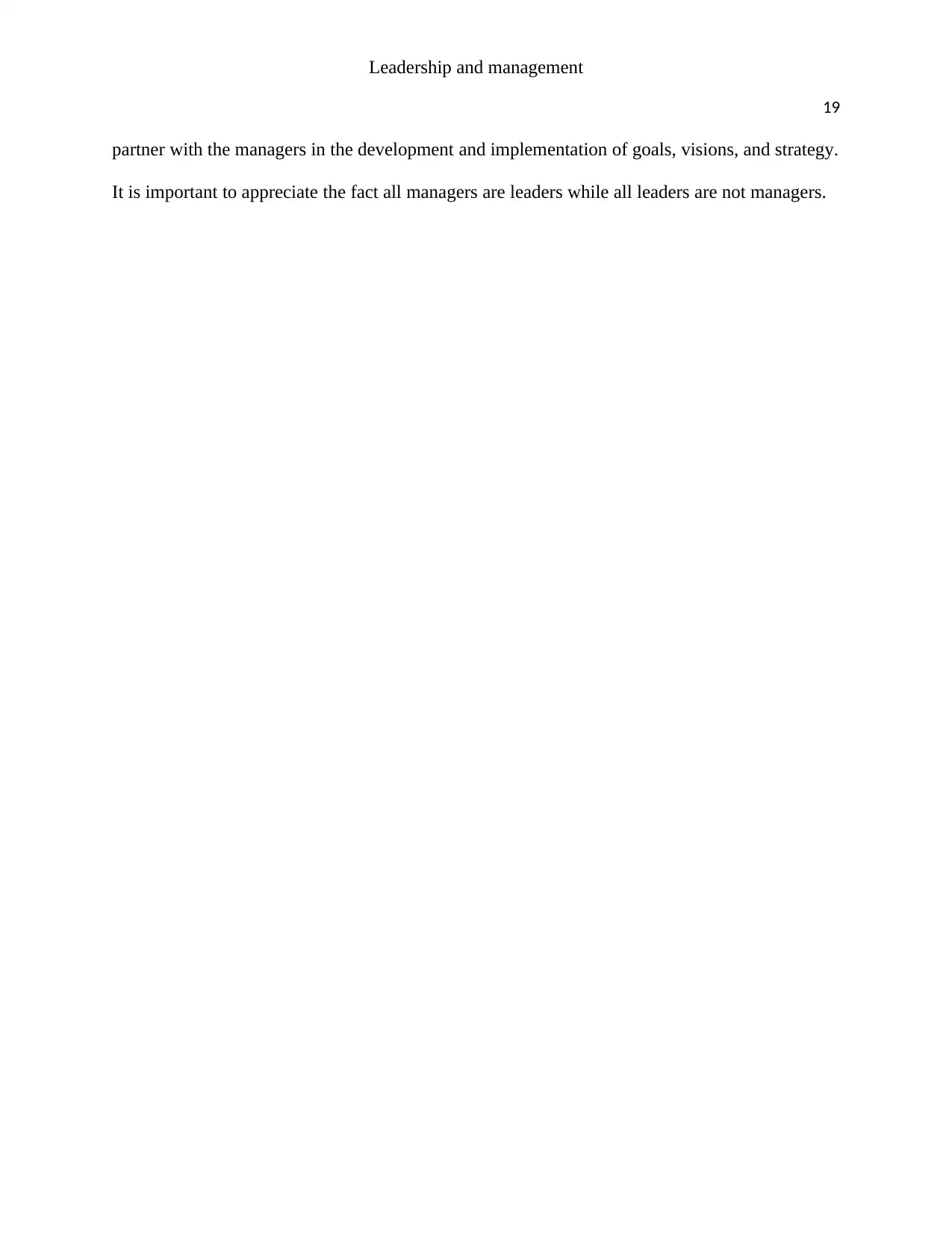
Leadership and management
19
partner with the managers in the development and implementation of goals, visions, and strategy.
It is important to appreciate the fact all managers are leaders while all leaders are not managers.
19
partner with the managers in the development and implementation of goals, visions, and strategy.
It is important to appreciate the fact all managers are leaders while all leaders are not managers.
Paraphrase This Document
Need a fresh take? Get an instant paraphrase of this document with our AI Paraphraser
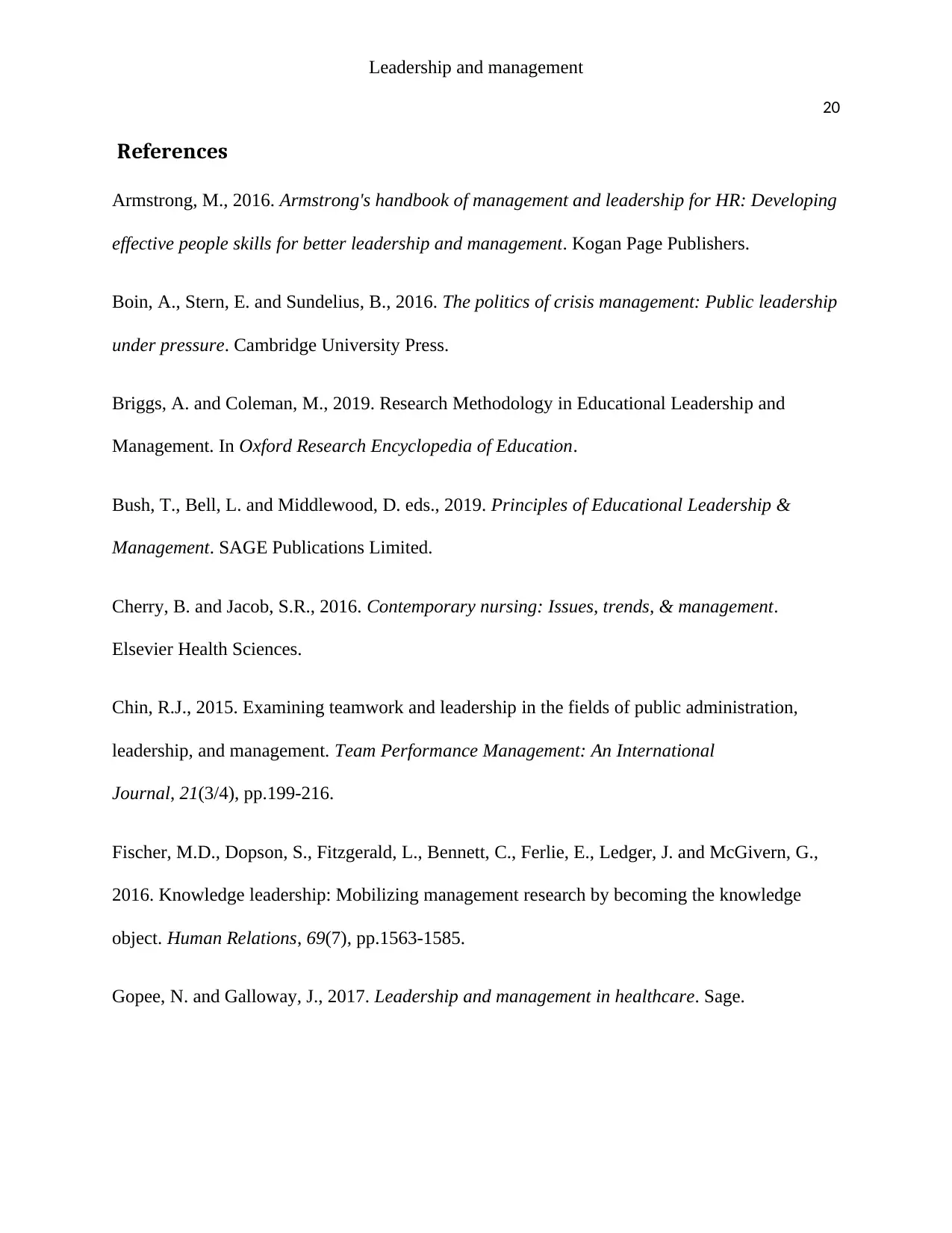
Leadership and management
20
References
Armstrong, M., 2016. Armstrong's handbook of management and leadership for HR: Developing
effective people skills for better leadership and management. Kogan Page Publishers.
Boin, A., Stern, E. and Sundelius, B., 2016. The politics of crisis management: Public leadership
under pressure. Cambridge University Press.
Briggs, A. and Coleman, M., 2019. Research Methodology in Educational Leadership and
Management. In Oxford Research Encyclopedia of Education.
Bush, T., Bell, L. and Middlewood, D. eds., 2019. Principles of Educational Leadership &
Management. SAGE Publications Limited.
Cherry, B. and Jacob, S.R., 2016. Contemporary nursing: Issues, trends, & management.
Elsevier Health Sciences.
Chin, R.J., 2015. Examining teamwork and leadership in the fields of public administration,
leadership, and management. Team Performance Management: An International
Journal, 21(3/4), pp.199-216.
Fischer, M.D., Dopson, S., Fitzgerald, L., Bennett, C., Ferlie, E., Ledger, J. and McGivern, G.,
2016. Knowledge leadership: Mobilizing management research by becoming the knowledge
object. Human Relations, 69(7), pp.1563-1585.
Gopee, N. and Galloway, J., 2017. Leadership and management in healthcare. Sage.
20
References
Armstrong, M., 2016. Armstrong's handbook of management and leadership for HR: Developing
effective people skills for better leadership and management. Kogan Page Publishers.
Boin, A., Stern, E. and Sundelius, B., 2016. The politics of crisis management: Public leadership
under pressure. Cambridge University Press.
Briggs, A. and Coleman, M., 2019. Research Methodology in Educational Leadership and
Management. In Oxford Research Encyclopedia of Education.
Bush, T., Bell, L. and Middlewood, D. eds., 2019. Principles of Educational Leadership &
Management. SAGE Publications Limited.
Cherry, B. and Jacob, S.R., 2016. Contemporary nursing: Issues, trends, & management.
Elsevier Health Sciences.
Chin, R.J., 2015. Examining teamwork and leadership in the fields of public administration,
leadership, and management. Team Performance Management: An International
Journal, 21(3/4), pp.199-216.
Fischer, M.D., Dopson, S., Fitzgerald, L., Bennett, C., Ferlie, E., Ledger, J. and McGivern, G.,
2016. Knowledge leadership: Mobilizing management research by becoming the knowledge
object. Human Relations, 69(7), pp.1563-1585.
Gopee, N. and Galloway, J., 2017. Leadership and management in healthcare. Sage.
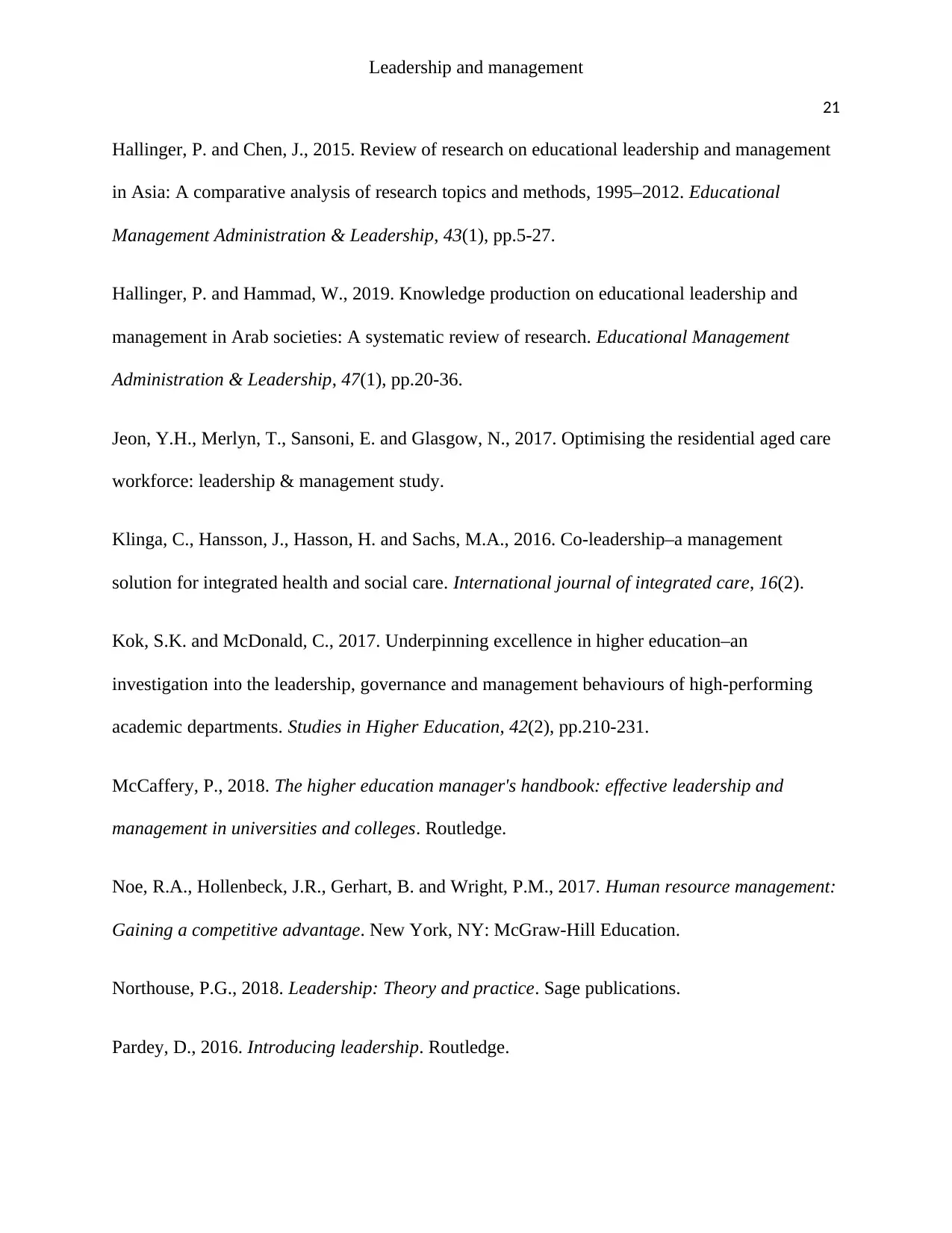
Leadership and management
21
Hallinger, P. and Chen, J., 2015. Review of research on educational leadership and management
in Asia: A comparative analysis of research topics and methods, 1995–2012. Educational
Management Administration & Leadership, 43(1), pp.5-27.
Hallinger, P. and Hammad, W., 2019. Knowledge production on educational leadership and
management in Arab societies: A systematic review of research. Educational Management
Administration & Leadership, 47(1), pp.20-36.
Jeon, Y.H., Merlyn, T., Sansoni, E. and Glasgow, N., 2017. Optimising the residential aged care
workforce: leadership & management study.
Klinga, C., Hansson, J., Hasson, H. and Sachs, M.A., 2016. Co-leadership–a management
solution for integrated health and social care. International journal of integrated care, 16(2).
Kok, S.K. and McDonald, C., 2017. Underpinning excellence in higher education–an
investigation into the leadership, governance and management behaviours of high-performing
academic departments. Studies in Higher Education, 42(2), pp.210-231.
McCaffery, P., 2018. The higher education manager's handbook: effective leadership and
management in universities and colleges. Routledge.
Noe, R.A., Hollenbeck, J.R., Gerhart, B. and Wright, P.M., 2017. Human resource management:
Gaining a competitive advantage. New York, NY: McGraw-Hill Education.
Northouse, P.G., 2018. Leadership: Theory and practice. Sage publications.
Pardey, D., 2016. Introducing leadership. Routledge.
21
Hallinger, P. and Chen, J., 2015. Review of research on educational leadership and management
in Asia: A comparative analysis of research topics and methods, 1995–2012. Educational
Management Administration & Leadership, 43(1), pp.5-27.
Hallinger, P. and Hammad, W., 2019. Knowledge production on educational leadership and
management in Arab societies: A systematic review of research. Educational Management
Administration & Leadership, 47(1), pp.20-36.
Jeon, Y.H., Merlyn, T., Sansoni, E. and Glasgow, N., 2017. Optimising the residential aged care
workforce: leadership & management study.
Klinga, C., Hansson, J., Hasson, H. and Sachs, M.A., 2016. Co-leadership–a management
solution for integrated health and social care. International journal of integrated care, 16(2).
Kok, S.K. and McDonald, C., 2017. Underpinning excellence in higher education–an
investigation into the leadership, governance and management behaviours of high-performing
academic departments. Studies in Higher Education, 42(2), pp.210-231.
McCaffery, P., 2018. The higher education manager's handbook: effective leadership and
management in universities and colleges. Routledge.
Noe, R.A., Hollenbeck, J.R., Gerhart, B. and Wright, P.M., 2017. Human resource management:
Gaining a competitive advantage. New York, NY: McGraw-Hill Education.
Northouse, P.G., 2018. Leadership: Theory and practice. Sage publications.
Pardey, D., 2016. Introducing leadership. Routledge.
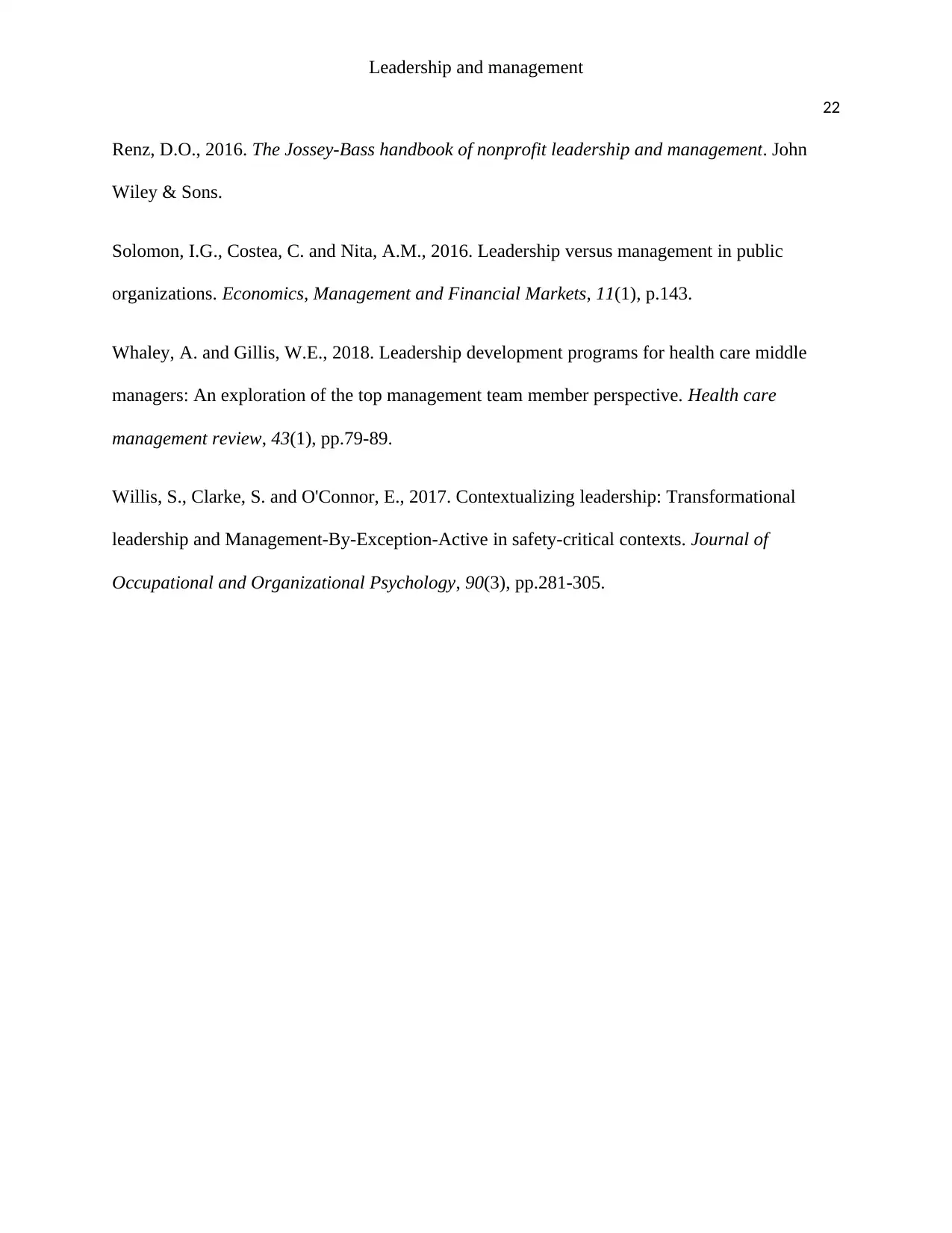
Leadership and management
22
Renz, D.O., 2016. The Jossey-Bass handbook of nonprofit leadership and management. John
Wiley & Sons.
Solomon, I.G., Costea, C. and Nita, A.M., 2016. Leadership versus management in public
organizations. Economics, Management and Financial Markets, 11(1), p.143.
Whaley, A. and Gillis, W.E., 2018. Leadership development programs for health care middle
managers: An exploration of the top management team member perspective. Health care
management review, 43(1), pp.79-89.
Willis, S., Clarke, S. and O'Connor, E., 2017. Contextualizing leadership: Transformational
leadership and Management‐By‐Exception‐Active in safety‐critical contexts. Journal of
Occupational and Organizational Psychology, 90(3), pp.281-305.
22
Renz, D.O., 2016. The Jossey-Bass handbook of nonprofit leadership and management. John
Wiley & Sons.
Solomon, I.G., Costea, C. and Nita, A.M., 2016. Leadership versus management in public
organizations. Economics, Management and Financial Markets, 11(1), p.143.
Whaley, A. and Gillis, W.E., 2018. Leadership development programs for health care middle
managers: An exploration of the top management team member perspective. Health care
management review, 43(1), pp.79-89.
Willis, S., Clarke, S. and O'Connor, E., 2017. Contextualizing leadership: Transformational
leadership and Management‐By‐Exception‐Active in safety‐critical contexts. Journal of
Occupational and Organizational Psychology, 90(3), pp.281-305.
1 out of 22
Related Documents
Your All-in-One AI-Powered Toolkit for Academic Success.
+13062052269
info@desklib.com
Available 24*7 on WhatsApp / Email
![[object Object]](/_next/static/media/star-bottom.7253800d.svg)
Unlock your academic potential
© 2024 | Zucol Services PVT LTD | All rights reserved.





